Microsoft E3 2011 Press Confrence Rundown
By count_zero 1 Comments
Well, I've recorded a video giving my thoughts on Microsoft's press conference. Additional videos for the other press conferences should be up through the rest of the week.
Well, I've recorded a video giving my thoughts on Microsoft's press conference. Additional videos for the other press conferences should be up through the rest of the week.
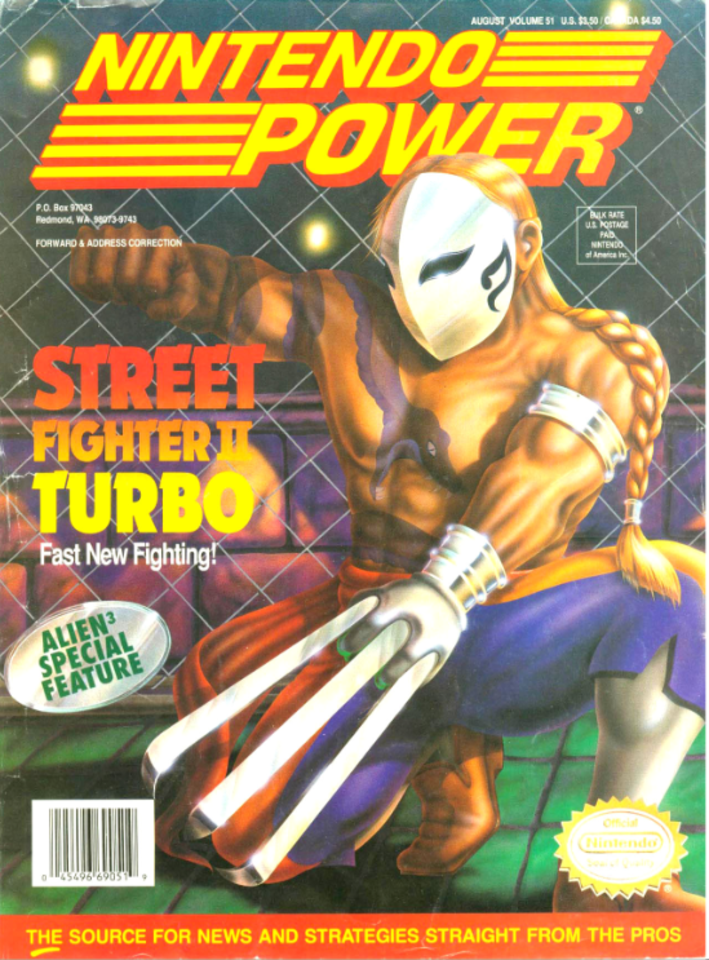
The issue is Nintendo Power #51, for August of 1993. Our cover game for this issue is Street Fighter II Turbo, which introduces the ability to have same character matches in the game, as well as the ability to play as the bosses, coinciding nicely with the release of Capcom’s latest fighting game to include Street Fighter characters – Marvel vs. Capcom 3.
In the letters column for this issue we have a letter from a 47 year-old chuck driver, looking for assistance with Blaster Master, and who has also been having problems with Final Fantasy Legend for the Game Boy. According to the writer, he got so frustrated with the game, that he nearly ran over his Game Boy with his big-rig until another driver stopped him (I presume this was at a truck stop). The writer discovered that the other driver had been stuck in the same spot in the game he was, and he got some instructions about how to get past that part of the game. I have to admit that I never thought of big-rig drivers as hardcore portable gamers before, but now that I’ve been exposed to the concept, I’m not too surprised. I wonder if the portable game systems are still popular with long-haul truckers today, and if so, I wonder what systems are popular?
This guide doesn’t give us precise tier info, but what it does give us is info on who is good against who, as well as rankings in speed, jump height, attack and defense, which is pretty much enough to let you work out tiers on your own.
Konami’s rather large action puzzle game is getting a guide. Yes, I’m calling it a puzzle game, as you’re basically navigating a maze, and have to manage your inventory and the optimal path to rescue as many neighbors and get as many power-ups as possible. It’s like Pac-Man meets B monster movies and smash TV.
Anyway, the game itself is fairly impressive with large, open levels (for the SNES) and a lot of them. The guide gives maps and advice for a smattering of them. I’m surprised that this wasn’t one of the first video games to get a published strategy guide, as level maps for this game would be immensely useful.
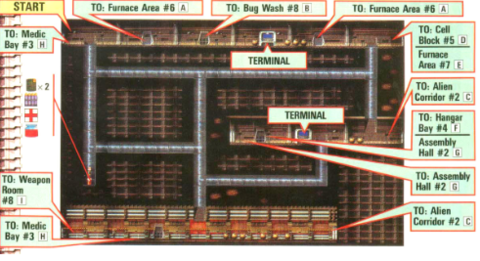
This issue Nester is playing “Link’s Awakening”. Our tip is that fighting in a doorway keeps you from getting surrounded. That’s on par with “Shoot Enemies to Kill Them” in Doom as far as obvious pro-tips are concerned.
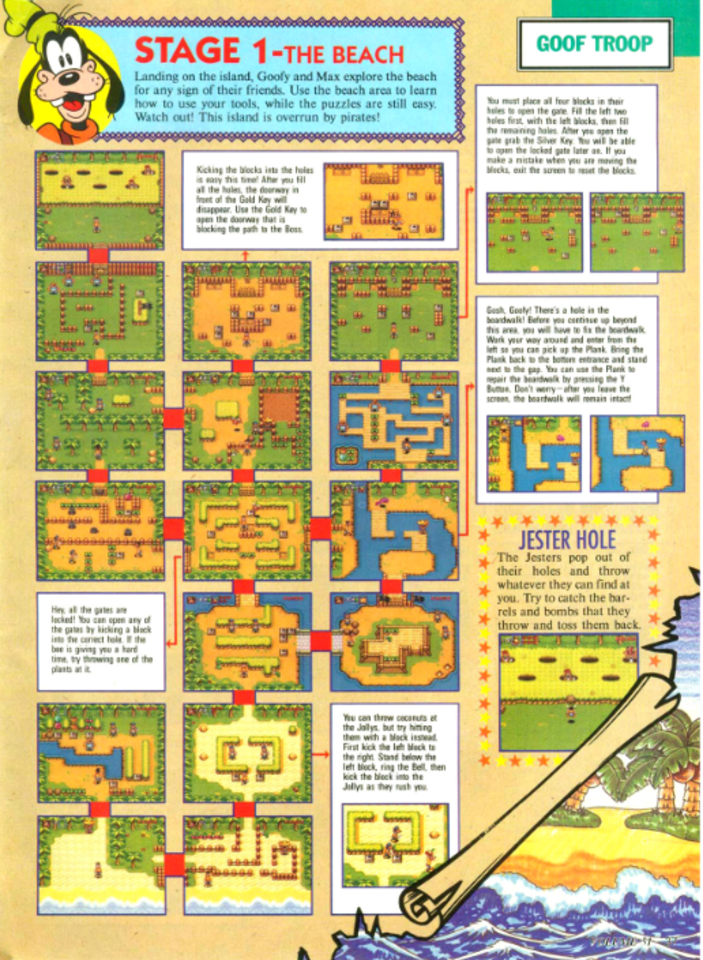
This is a Formula 1 Racing game for the SNES, NES, and Game Boy. We get maps of all the courses of the game, including recommended speeds for the various turns. Most of the tracks are based on real courses, and I can’t help but notice that the German track is based on a configuration for the Nurburgring.
We also get some comparison information on the NES and Game Boy versions of the game.
We get cheats for Super Double Dragon, and Super Valis IV, along with what the Konami Code does on Turtles in Time and Batman Returns from Konami (gives 10 lives in TMNT and 9 on Batman, except you have to enter the code on the second controller and hit start on the first controller).
You get some additional cheats for the Combattribes, Deadheat Scramble, Mega Man III (the Game Boy version), and Flying Warriors for the NES.
Our heroes are attacked by space stingrays, and then encounter a space ship shaped like a humpback whale, with Fox’s father aboard. You know, I don’t remember anything like this in the first Starfox game.
Just a little feature article to help you get the names of games in various franchises straight.

This looks to be an odd little semi-sim. I can’t really tell how the game is played from the preview, but from what I can tell this is a game that would work better on the PC then on consoles.
Basically, this is Klondike Solitaire, Dominos, Cribbage and Yacht(zee).
We get tips on the ninja RPG Inindo and Road Runner’s Death Valley Rally. We get info on training up party members in Ultima V,a s well as questions on getting Lord British’s Crown and raising the dead. There’s also puzzle advice for Final Fantasy Adventure, and complete level maps for acts 1 & 2 of StarFox.
This is, essentially, a home port of the game boy game. That is not necessarily a good thing. We get maps of stages 1 through 3.
While adventure games do well in Japan, and a few western adventure games came out in the US. However, no adventure games as unforgiving as those by Sierra Online had come to consoles before…
Until now.
I’m not entirely convinced that this is a good thign. We get some notes to get you partway through the game, but not all the way through.
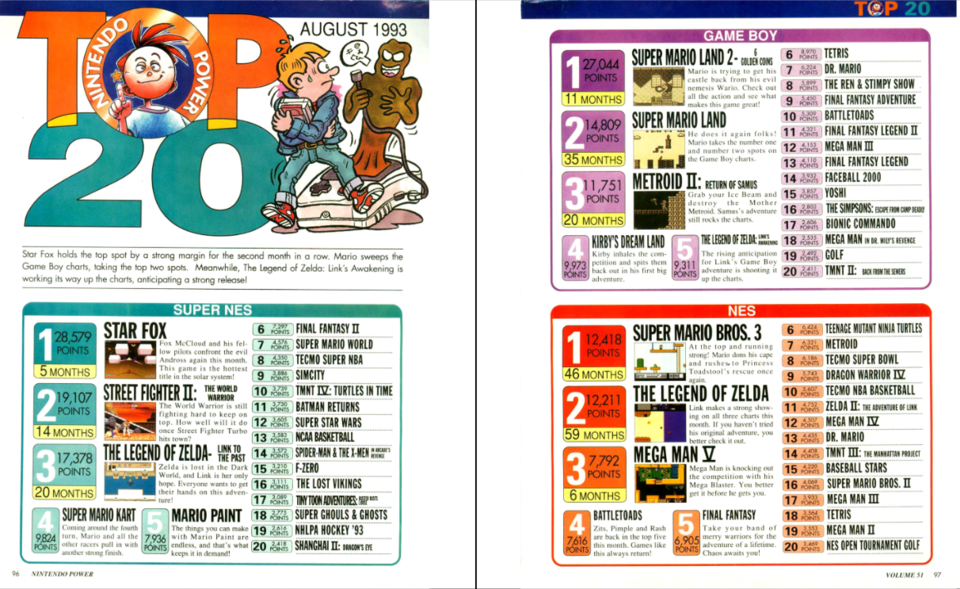
Also, as an aside, we have an Alien^3 contest where you can win a full size Alien replica, and Ripley’s Cryo-tube! Second prize is a copy of Alien 3 for the SNES and a VHS of the movie. Rather impressive.
First up, we get a look at FInal Fight II, now (finally) with two-player, and the prostitutes still changed to transgender characters – because homophobia and transphobia is so much more acceptable. Also of note is Activision’s Alien vs. Predator brawler, First Samurai from Kemco (an action platformer), the Bram Stoker’s Dracula licensed game, and a new Spider-Man game for the Game Boy.
Interplay is working on their own fighting game with Clay Fighter. Ubisoft has F1: Pole Position. Tradewest has Plok, Namco has battle cars. Spectrum Holobyte is working on a new Star Trek: The Next Generation game that will, hopefully, work better on consoles than on the Game Boy.
Maxis also has a port of SimAnt, and Capcom has two more Mega Men games, Mega Man 6 for the NES and Mega Man 4 for the Game Boy.
My quality control pick for this issue is going to be Goof Troop. This is different enough from your standard Disney licensed platformer to make things interesting.
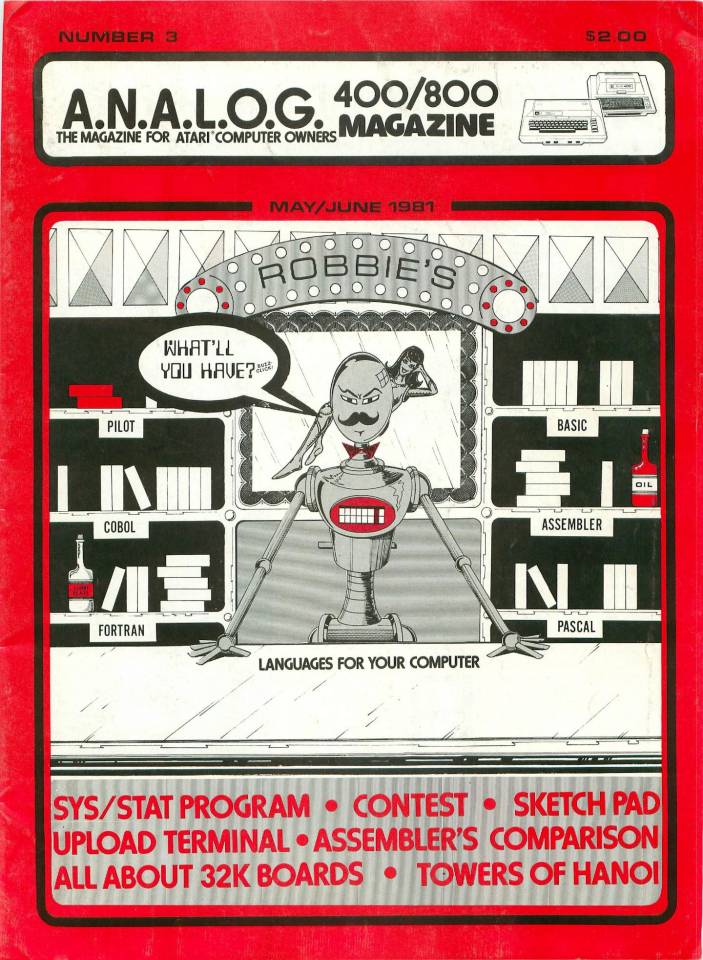
First up, we learn that our editors are full-time college students, and because of their course schedule, they're going to have to ease back on their publication schedule, as not only are they the editors of the magazine, but they're also the entirety of the writing staff. I'd cut them some slack, except they have to be all snide and snarky and talk about how other editors don't know all the work it takes to make a magazine, something which, bare minimum Steve Harris and Dan Hsu would take issue two.
They also have a call to fight against computer piracy, as it discourages publishers from supporting the Atari 8-bit platforms over the inferior (their words) Apple and Texas Instruments systems. We also get a call for more article submissions – pity your poor, poor writer-editors.
We get a massive letter complementing them on their Composer articles, as well as a request for more advanced programming articles. There's also a request for contact and ordering information for a few hardware manufacturers. Another reader wants to know about this “Compuserve” thingie. There's a request for a review of a recently released Apple emulator, and information on wargames for Atari Computers. Well, if you're a little patient on that last front, SSI will have some stuff that should scratch that itch. Finally, the director of Kurta Corporation has a correction for their review of their tablet from last issue. Apparently the $100 does more then buy you some demo software... it will also buy you the power cables for the tablet, as well as interface cables to hook it up to your computer... so you can actually use the tablet. Congratulations, you just un sold me.
Dow Jones has some investment management software. Microsoft has announced their upcoming release of Atari BASIC at Summer CES. Plus there's a new assembler app coming out. Floppy drive production by Atari has also been stopped briefly to incorporate some new changes to cover reading information off of disks that were written to by drives of different speeds. It probably seems odd to you that something like this would require a significant change to drive designs, but remember that around this time consumer floppy drives were fairly new.
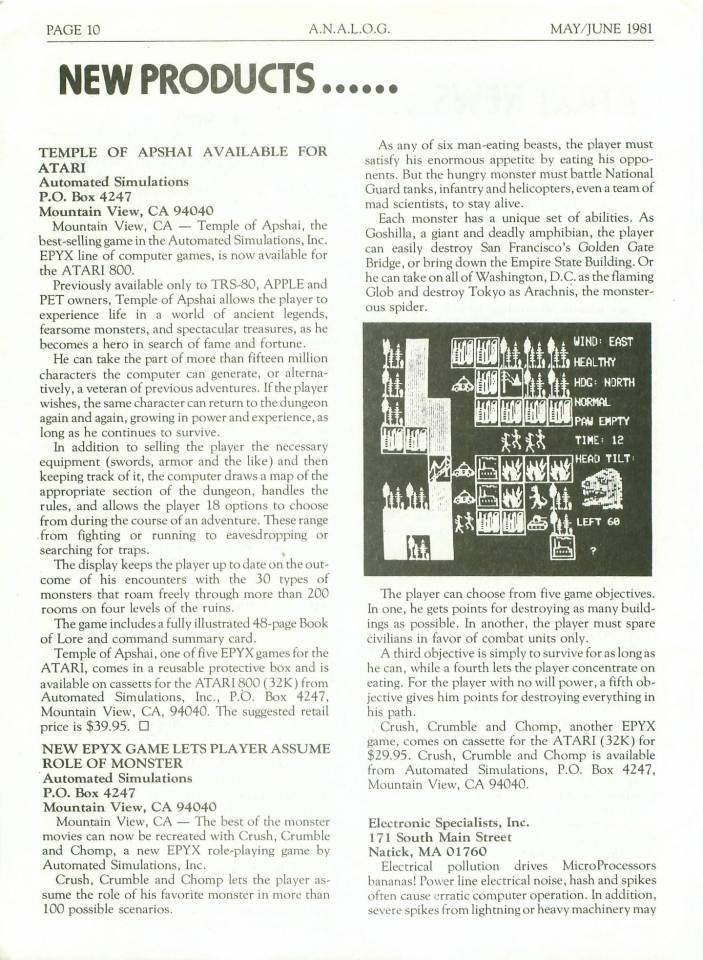
Temple of Apshai, the latest game in the DunjonQuest series is getting a port to Atari 8-bit systems. The game's publisher, Automated Simulations, is also putting out the Kaiju game “Crush, Crumble and Chomp” where you have to destroy as much of the city as possible before being stopped by the military. Optimized Systems Software in Cupertino also has a new variant to Basic, called Basic A+.
A program listing for an application to provide information on attached devices and whether the system recognizes something being there. Useful for troubleshooting.
This listing basically expands the range of sounds your computer can handle so it can do sounds in the base range. I don't know how good bass sounds sound on Atari 8-bit systems though, especially since the sound range isn't normally accessible.
This installment in the series covers the Assembler, and some of the option commands.
This is an assembler program, if you couldn't tell from the title. They like the program, though they don't like that you're required to use the bundled text editor for your coding.
No relation to Word Perfect. I'll give them props for disclosing that this is a program that's advertised in the magazine. Unfortunately, they review commits the cardinal sin of being apologetic. The opening of the review describes it as being one of the best word processors they'd ever used, but then proceeds, in the course of using the review as a tutorial for the application, they enumerate a litany of problems with the application, to the point that they had to send the program back to the manufacturer and get a patched version back. This would be bad on its own, but the fact that the program costs $150 in 1981 dollars just makes it worse.
If you've played a Bioware game, you know this.
Atari has released Othello, Video Pinball, and Missile Command, and Activision has released Freeway and Kaboom. In terms of upcoming titles, we have Ice Hockey and Stampede announced by Activision, and Warlords, Asteroids, Super Breakout and Haunted House from Atari. Also, we get a heads up that 2600 carts don't work on an Atari 8-bit system, in case you didn't already know.
Basically, this is a suite of file-management applications. They like it, and it's actually less expensive then Letter Perfect at $40.
If you couldn't tell from the title, this is a typing tutor program, to help you speed through those program listings in the magazine. They like the program, though it has its problems. However, considering there's not a lot of competition for the time, you'll probably have to take what you can get.
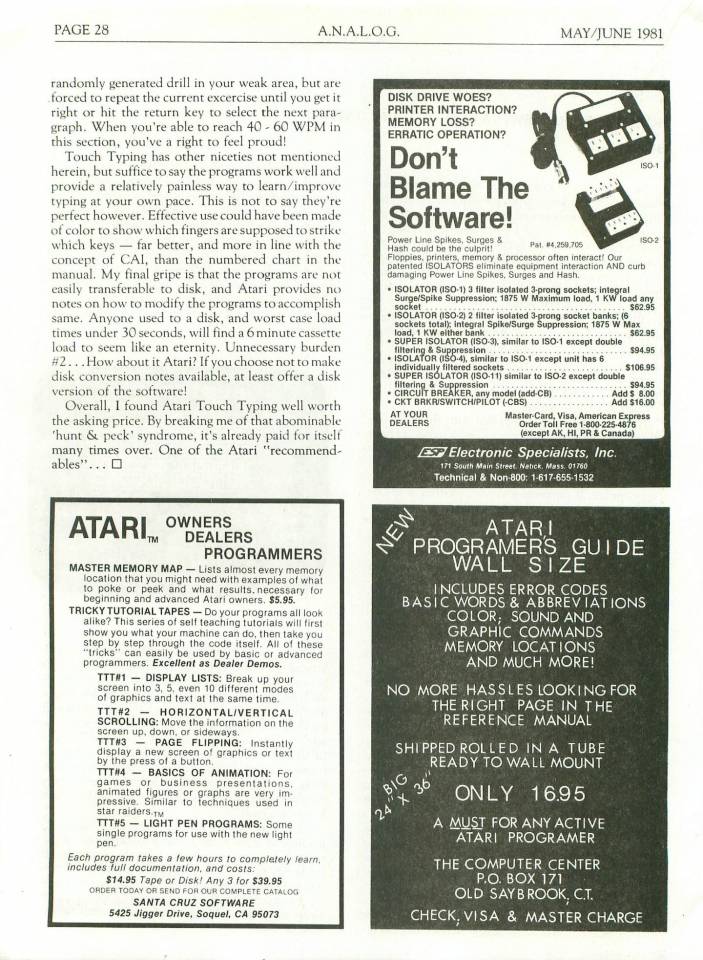
They like this (unsurprising), though they don't like how it handles strings.
This is a review of the Atari 8-bit version of the game. This version does have 2 less cities (and thus less missiles) than the arcade version, and you're using a joystick instead of a trackball, so take that as you will.
Basically, this is a shooting gallery game that you control with a joystick.
This is a basic drawing application which lets you draw lines and fill closed areas with solid colors. Nowadays this isn't much, but for a two page listing, that's rather impressive.
Target Blockade is a multiplayer snake/Light Cycle clone, and Battle Warp is a Space War clone. These reviews also have numerical scores, though we don't get any information on the scale.
This is a column about online services, wit ha par for the course hating on Apple users and their computers. This issue covers uploading a program listing instead of manually typing in while connected with your 2800 baud modem. This includes a couple listings to help with the uploading process, as FTP clients haven't been invented yet.

Want to pimp your comp? Well, check out these boards that will give you a whopping 32K of memory. The boards even have gold plated connectors so they won't oxidize causing your computer to crash and you to lose your data. Oh, and here's an ad for some of the external memory upgrade modules you can get - that's right, external memory upgrade modules, when you run out of space inside of your computer.
We have some corrections for earlier listings
We have more advice on writing better code for Basic on Atari 8-bit systems. We'll wrap this up for an add for a joystick.
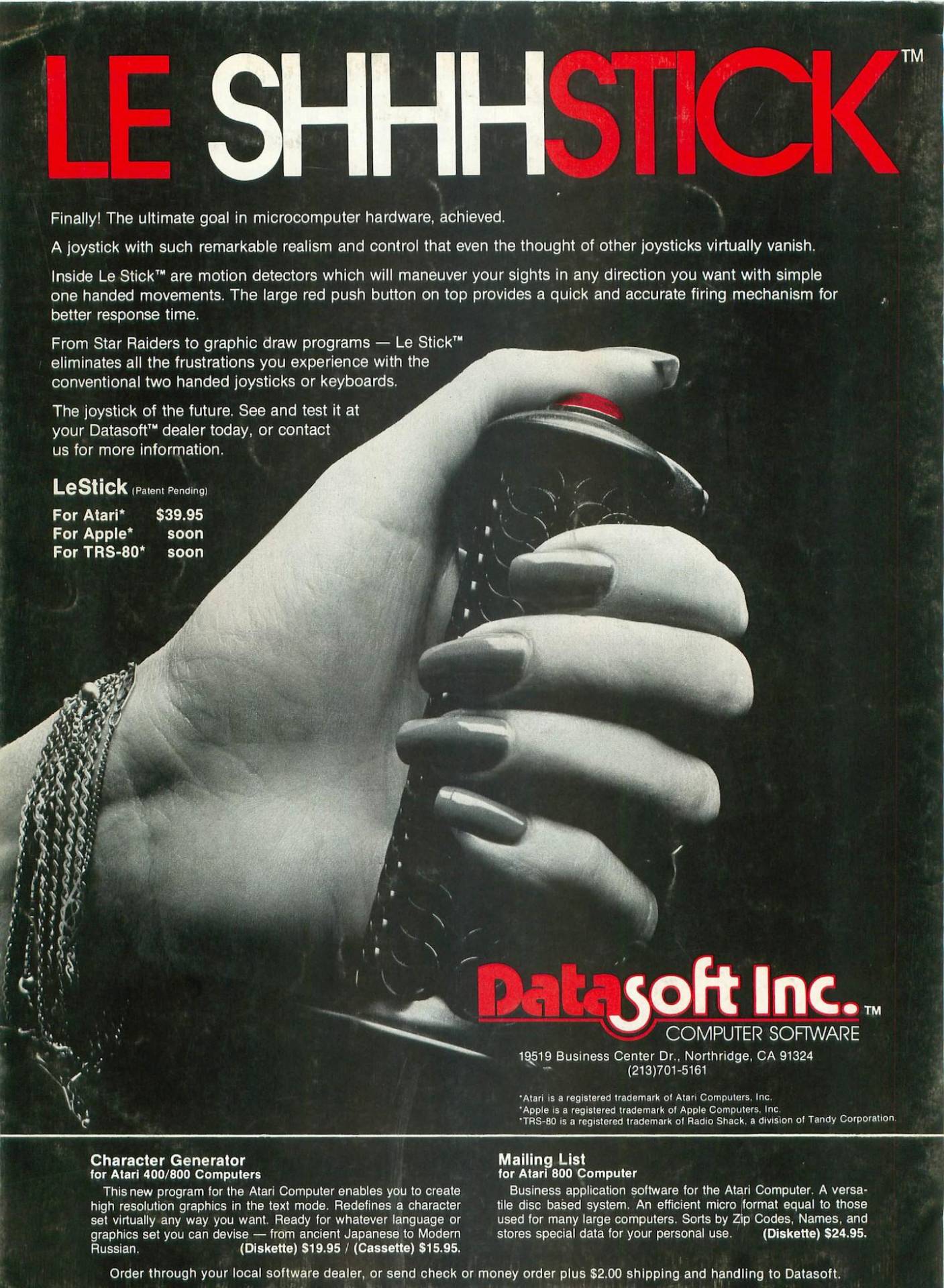

Just in time for the 25 Anniversary of the US launch of the Nintendo Entertainment system, my Where I Read for Nintendo Power has reached issue 50, for July of 1993. It shouldn’t be a surprise to say that this issue’s cover game is a notable one – Legend of Zelda: Link’s Awakening for the Game Boy – the first portable outing for the series.
Our letters column for this issue has an interesting question – when they added two more face buttons on the SNES controller (in addition to the two shoulder buttons), why did they call them X & Y instead of C & D? According to the official answer, it comes from CAD, and relates to the fact that X & Y are the secondary buttons, as opposed to the main A & B buttons. I don’t know enough about CAD to say how definite that is (aside from X & Y being the axis for any two-dimensional plane), but it sounds good. If anyone who knows more about CAD wants to chip in with more information on what could be referenced here, I’d appreciate it. We also have a couple good-bad Legend of Zelda jokes, from Alex in Victorville, CA:
Q: How did Link help his team win the basketball game?
A: He used his hookshot!
Q: What did Zelda tell Link when he couldn’t unlock the door?
A: Triforce. (Get it, “try force” – I’ll get my coat)
So, just to get the age of game across here – it still has WWF in the logo instead of WWE. It’s got the Big Letter logo instead of the Scratch logo. The Undertaker has a goatee only, no moustache. Also, it bears mentioning that of the five wrestlers pictured here – Bret Hart, The Undertaker, Rodney “Yokozuna” Anoai, Curt Henning, and Scott “Razor Ramon” Hall, two are dead (Henning and Anoai), one is out of the business due to being an alcoholic (Hall), one basically can’t actively wrestle after having too many concussions (Hart), and one’s retiring Real Soon Now (The Undertaker). Hey, at least it doesn’t have Chris Benoit in it, if it did then the game wouldn’t exist anymore. ![]()
The game itself has four gameplay modes – single player career, tag team career, three-man tag, and battle royal. It’s interesting to note that when wrestlers use a chair as a foreign object, they hold it upside down. Of course, like most steel chairs on WWE programming, they can only withstand a couple swings before becoming unusable for anything really. It’s also interesting to note that while the game has a tag team mode, only two real “tag teams” are represented here – Mr. Perfect and Ric Flair, and Shawn Michaels and Razor Ramon, and both those are situations where one wrestler was the other’s “bodyguard”, not that they were a regular tag team and neither team ever held the Tag belts. I bring thus up because earlier games usually had one tag team in it that had held gold, usually the Road Warriors/Legion of Doom, or occasionally Demolition.
We get a list of wrestlers here, and their signature moves – which is a new touch for WWE games. However, the game doesn’t include submissions, something that WCW’s first game did include. I don’t recall if this game includes rope breaks on pin attempts though. Still, from a feature standpoint, they’re behind their competition.
This is a sort of run and slash action-platformer like Strider. We get maps of the all the stages before the last one, including boss strategies. Of note – according to wikipedia, the boss for level 2, a massive reclining undead woman, was originally just a massive reclining woman in the Japanese version, but Nintendo of America had them change it to avoid their “No Violence Against Women” policy – the same policy that lead to the stripper-riffic women from Final Fight being changed to transgender men in the US release of that game. Yeah, their priorities weren’t in the right place.
Before Will Wright gave us Spore, we got this ambitious title from Enix for the SNES. Basically, you control a creature of your own creation, and earn Evolution Points by surviving, by eating creatures and so forth. Evolution points can be spent on various genetic mutations that will help you do better later on. For example, as a fish, you can evolve a lure similar to the lure of the angler-fish, to help draw in food.
We get a run down of various edutainment games as we approach back-to-school season. Several of these games, like the Miracle Piano Teaching System, have previously been covered by the magazine, and nothing is really in-depth.
This game is a little interesting, as while the game was originally licensed when it was released on the SNES, the Genesis version was initially unlicensed (a licensed version was released later). We get maps for levels 1, 4, 7, 10, 13, and 16 (the final stage). We don’t get any boss information though, it’s entirely possible that the game doesn’t have any bosses until the end, or that the bosses are on the levels we don’t get maps for.
We also get a gallery of the covers of all of the last 50 issues of Nintendo Power. Thus far I have to say that I like the cover of issue 2, the Castlevania II cover, the most. Our Nester’s Adventures strip covers TazMania and is has no useful advice at all.
This is, as it says, an in-depth retrospective. Apparently they consider the Castlevania II cover their “worst” cover, because it gave kids nightmares. Personally, I would say any piece of cover art good enough to cause nightmares would be a sign that it’s quality. Anyway, the official history here downplays the magazine’s role as a piece of advertising, instead describing it as a way to give a lot of information about Nintendo games for fans, and not including advertising as a way to avoid any awkward conflicts of interest, never mind that this is a house organ, and thus will probably skip on saying anything too negative about their products.
At the very least, they attempt to leave the American kusoge (shitty games) out of the magazine, and to be fair, with the Quality Control picks I’ve played, while some are bad, I haven’t seen anything as bad as Deadly Towers, or the far, far worse Dragonlance: Heroes of the Lance in the magazine, at least not very often.
While the Starfox comic continues, I’m still not going to cover it because it’s still not good.
So, this guide covers enough of the overworld map to get you to the first three dungeons of the game, and maps of those dungeons. That’s unfortunately it. Most other guides usually give a glimpse and maybe a few hints of what’s to come later, but this has none of that, unfortunately.
This is a sequel to the spinoff game based on Ghouls & Ghosts/Ghosts & Goblins. We get strategies for all the bosses right off, as well as a full two-page spread of the overworld map. We don’t get maps of the dungeons, but I’m okay with that. Frankly, I wouldn’t have minded if, with Legend of Zelda, we had gotten no maps of the Dungeons, and just gotten a complete overworld maps and a few useful notes on the dungeons (for example, in this dungeon you can only defeat some enemies with jars, and you can only lift those jars after you find the Power Bracelet in this dungeon).
This is a port of the arcade light gun shooter… for the Game Boy. Yeah, no good can come of this. Mind you, I liked the arcade game, but light gun games really need to be played with a light gun – either one hard locked to the machine (T2, Operation: Wolf), or a couple on cables, possibly dual wielded.
Moving to the NES, we have a licensed game based on the Addams Family animated series. I watched this show a fair bit as a kid, and I have to say that the animated format probably worked better for the Addams Family than the live action format, at least outside of big features like the two films with Raul Julia. We get a map of the hub area and notes on the individual levels, but no full maps.
So, what do you do when you want to port one of the best fighting games of the last 5 years to the NES, when the system can’t handle it? You put out a Super Deformed version! Thus, we have Mighty Final Fight, a version of Final Fight with Chibi characters. Plus, it has a level up system, and we have Guy in the game! We get maps of the levels and notes on beating the bosses. Frankly, I like this game’s visual style, and I’m probably going to make it my Quality Control pick.
Remember Bubble Bobble? Good. Now you’re getting more of it. We get notes on a smattering of levels from the game and their World’s bosses – 3, 11, and 15 in World 1, 21, 24 and 36 in World 2, 42, 45 and 59 on World 3, and after that is the final world.
We also get a mini-merch catalog, which includes the opportunity to get every single back issue of Nintendo Power for just $50. That’s actually a pretty good deal. There’s also a Member’s Only shirt, and the Legend of Zelda and Super Mario Adventures graphic novels.
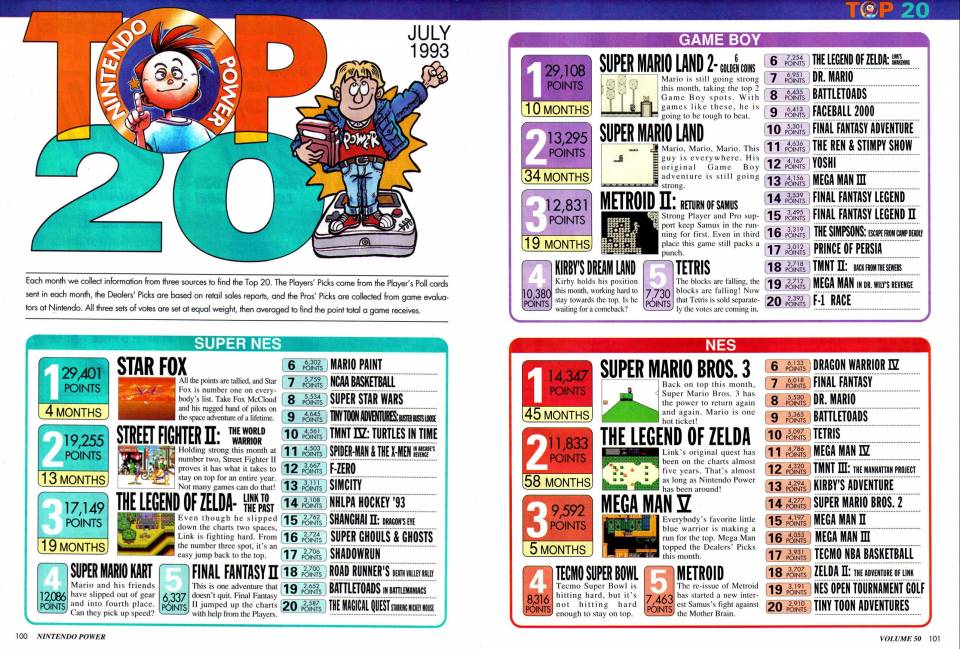
For our Top 20 this issue, Star Fox now holds the top spot on the SNES, bumping down Street Fighter II (original version) and Legend of Zelda: A Link to the Past. On the Game Boy, Super Mario Land has once again been bumped off the top spot, and not by Metroid II. Instead, Super Mario Land 2 has claimed the top of the charts, pushing Samus and Kirby further down the charts. On the NES, Mario 3 retains the top spot, followed by the original Legend of Zelda (who has been on the Top 50 for the magazine’s full run), and Mega Man V. It bears mentioning that every NES Mega Man game is on the charts and every Metroid game released as of this issue is on the charts. We are missing Zelda 2 from the charts on that franchise, and the original Super Mario Bros and Super Mario World are absent from the charts from that franchise.
Now for the best of the rest. Ultima VI: the False Prophet is getting a SNES release. Unlike the PC games you can’t carry your character over from the last game. Seika is releasing Super Turrican, JVC has the Wizardry clone Dungeon Master, There’s also a Game Boy game based on Star Trek: The Next Generation.
As my favorite wrestling commentator, Jim Ross, is fond of saying, business is about to pick up. Capcom is preparing to release Street Fighter II Turbo, with the ability to play as the bosses, as in Champion Edition, plus a speed boost. However, Midway has their own major fighting game on the way, albeit in a bowdlerized fashion – Mortal Kombat. By bowdlerized, I mean that many of the finishing moves have been toned down, though the people writing this column attempt to downplay this – and fail. Ultimately, this game, more than Sonic vs. Mario, is what truly divides the Genesis vs. SNES camps.
Konami also has a fighting game of their own, with Teenage Mutant Ninja Turtles: Tournament Fighters. This one also has its own differences between the Genesis and SNES versions. The SNES version has more characters from the animated series (like Bebop and Rocksteady), while the Genesis version includes more characters from the comics (like Casey “10 Minutes For High-Sticking” Jones). Finally, Capcom is taking Mega Man to the next level with Mega Man X for the SNES.
Finally, for my Quality Control pick. While Super Turrican in the Now Playing section caught my eye, I’m going to go with Mighty Final Fight.
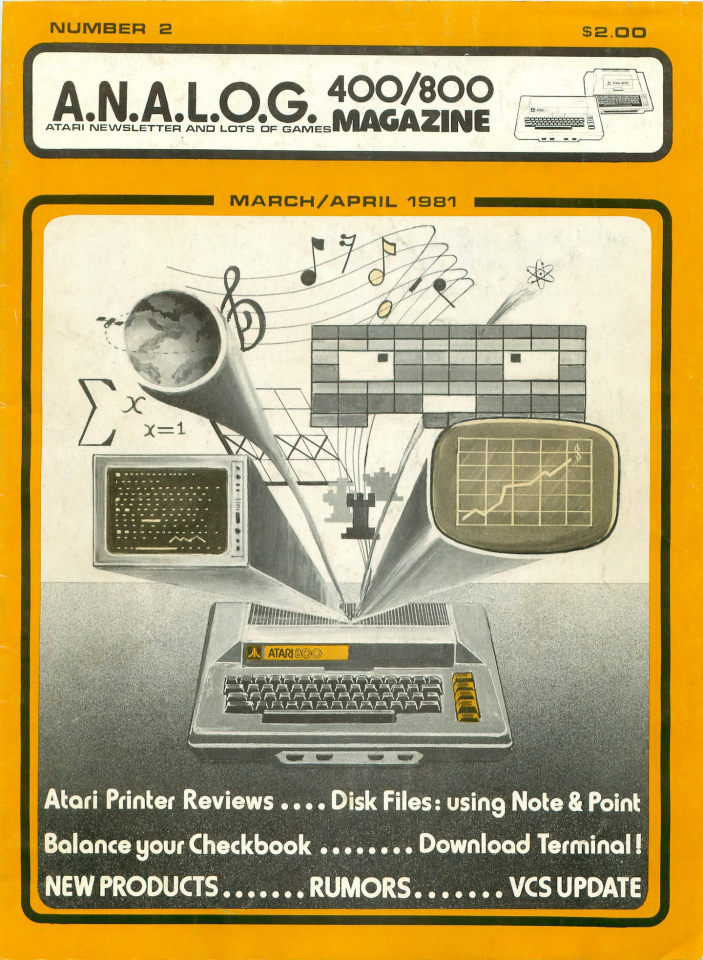
We move on with the issues of Analog Computing with its sophomore issue, for March and April of 1981. As you can see from the cover, we’ve got coverage of some printers for the Atari 8-bit systems.
Last issue’s Editorial column was a statement of principles, while this issue’s column is a request for feedback from readers asking what they’d like the magazine to become. They also stated that at the behest of Atari dealers they’ve decided to stop running ads for their own Atari software. That’s kind of disappointing. Yeah, it could be construed as being biased in that you’re not reviewing your own apps, but on the other hand, that they’re publishing their own software provides a bit more clout to their reviews – they’ve developed for the system, so they know what software development for it entails.
They’ve also announced that they’re not going to run ads for mail-order houses or specific retailers. I can kind of get why they’re doing that, but it still feels like a boneheaded move to me. Part of having editorial integrity is, in my opinion, you run ads for the people you want to run ads for, in accordance with your ad policy – and once you’ve set your ad policy, you don’t change it because retailers who carry your magazine get pissy because you’re running ads for competing firms. Considering that last issue they strongly came out in favor of Atari fanboyism, their yielding compromise here feels a little depressing.
Additionally, they’re accepting program submissions, for review, and possibly for listing. They’re also announcing that since they stopped running ads for their own products, they’re depending more on advertisers for revenue instead of subscriptions. Since they’ve also cut mail-order firms and other retailers from their list of approved types of advertisers (which is something that EGM didn’t even do), then this could be a little tricky.
That was fast. Usually it takes an issue or two to get letters, at least that show up in time for deadline. I guess that being bi-monthly makes that less of a problem.
Our first letter has a possible solution for the program lock-up problem from last issue. Apparently the “BYE” command can clear up lockups like this. I can’t find the details, but presumably BYE is the kill process command. The letter also had a little news tip of interest. Apparently Ham Radio operators who are also Atari enthusiasts were trying to start some sort of Atari Ham Radio program on Monday nights at 8 PM eastern, at 14.329 Mhz. It’s kind of interesting, the ways computer enthusiasts found to exchange information, before Usenet started finding its way outside of academia.
Letter number two starts off with asking about what readers have permission to copy. Remember when you had to have written permission to photocopy stuff? I’m glad those days are over. The writer also runs down a few computer issues that the customer doesn’t have to be in warranty to have Atari fix, even if the computer is out of warranty. Most of these problems involve adding or removing capacitors from the motherboard. Also, apparently crossing your power cable with your printer cable could cause RF interference. God, the loads of cables coming out of the back of my tower would have tremendous problems with RF interference back in the day. We also have an alternate method for making hyperspace jumps in Star Raiders.
There’s a bit more stuff related to contacts on Atari computers, and that Atari might want to switch from their current contact design to gold-plated ones for improved conductivity. There’s also a letter from the head of marketing at Axlon Inc, hyping their new memory module for the Atari 800, that can expand the system’s memory up to a stunning 256KB of RAM. No one could possibly need more than that!
Another writer brings up the TRS-80 and the Apple, and how Atari is the last hope for the industry since those systems are crap and won’t be anywhere in the future. Well, he’s half-right. Finally, we get a very impressive letter from an 8 grader with what is basically an article submission, explaining what the PEEK and POKE commands do. It’s not perfect, but this probably the first time this kid has done technical writing, so I’ll cut him some slack. Wonder what he’s doing now.
Atari is working on an accounting suite for businesses. It has an Accounts Receivable system capable of handling up to 300 customers at a time, with a max of 1200 monthly customers. The General Accounting application can handle 2700 transactions a month for up to 750 accounts and finally, Inventory control will handle covering stocks of up to 1000 different items. All in all, this sounds like a decent application for a small business.
Atari’s also working on a word processing application, which I’ve used and I’d say it was okay when I was in grade school, but now I prefer WYSIWYG applications like OpenOffice or even premier.
First up is a brand spanking new modem for the Atari from from the Micro-peripheral corporation. The modem includes a printer interface, so it can print off everything you see on your screen for later reference, as well as a tape recorder so you can record the information you viewed for playback later. Or, to put it another way, the tape recorder lets you save files. Frankly, that’s kind of awesome. It’s horrifically dated now, and even if I had one of these, I wouldn’t be able to use it as the BBS services would no longer be up and running. Still, were this the 80s and were I a hacker or just a general geek who hung out on BBS services, I’d want this so freaking bad. That said, this would cost $249 in 1981 dollars (approximately $546 now).
Activision has home ports of Kaboom and Freeway for the 2600, both of which have been released for Game Room, and have been covered on GiantBomb.com’s Game Room features. Meanwhile, Automated Simulations has a few games for the Atari 8-bit systems under their Epyx brand. They have The Datestones of Ryn, Invasion: Orion, and Rescue at Rygel. None of these I’d heard of before. Manhatten Software (that’s not a typo – at least not my typo) has a casino blackjack game designed to teach you how to get thrown out of casinos by counting cards. For the record, fuck casinos who treat card counting like cheating.
We have our first program listing of the issue, with a 100-item inventory management app. While the application isn’t very useful in modern systems, the listing might offer a little useful information on the theory of designing database systems.
A column from Charles Bachand about being a better programmer – particularly with regards to using system resources more wisely. Bachand boasts that the programming techniques he recommends will cut down on memory space used by 80%. First, they recommend using single byte numbers (255 or less) through a chunk of memory (about 256 bytes large) starting at the memory location 1536, or $600 if you’re using machine language. These sections would have to be accessed with PEEK and POKE.
Next, you can hack basic to handle the limitations for array storage. Basically, (no pun intended), in ATARI BASIC, Arrays – places you store variables are designed to only be able to be two-dimensional, and there are some limits to their size in two-dimensions. Thus, if you’re making a lot of variables, you might end up needing multiple arrays. Well, not anymore, as Charles has a hack for you that lets you create 3-dimensional arrays instead. Finally, if you need arrays that are bigger than the 256 byte space at 1536, they recommend using DIM to define the arrays… as strings.
Now, all this programming advice is very useful if you’re doing, say, Atari 8-bit home-brew programming. However, if you’re using anything else then this advice won’t nearly be as useful, as modern versions of C, for example, handle memory usage differently then ATARI basic would.
This is sort of like the Quartermann column, but not presented in anything near as interesting a style. Of note in the rumors are:
We get an ad for Letter Perfect from LJK Enterprises, a word processing program that boasts the ability to adjust your header and footer, and even delete whole lines of text, all for the low, low price of $149.95.
For our next program listing, we’re continuing with the practical programs with one to help you balance your checkbook. This code is a little better documented than the last app. Still, there are already existing open source apps you can check out if you’re looking to write your own checkbook app, like HomeBank.
Like the title says, this article covers Player/Missile graphics when you’re writing games. What are Player/Missile Graphics you ask? Well, with Atari systems, the “player” is whatever sprite on-screen that’s being controlled by the character. The missiles are autonomous sprites which move on their own accord, based on rules set by program. They don’t give the details for what this program listing does, but my suspicion is that it’s a Space Invaders clone.
I suspect that if you were a programmer in the 80s, and Spam E-Mail existed, instead of herbal Viagra, you’d get messages telling you how you could unleash your CPU’s inner power. Anyway, this article does have some useful information, like how the system has a dedicated GPU, called ANTIC. To my knowledge this makes for the earliest computer system to have a GPU. Anyway, Basically, their way of boosting your processor speed is having your system stop using the GPU if it has to some heavy thinking, whether it’s math calculations or plotting out a chess move. That would explain some of the blinking in the 2600 version of Reversi that’s on Game Room (as commented on by Jeff and Ryan) in past Game Room Rundowns. For those who are wondering about that, Reversi is one of the games commonly used when designing AI systems. Chess is used as well, as is Go – though people working on more advanced game algorithms have yet to design one that will work for Go, due to the game’s complexity.
This is a listing for an artillery duel game, one which doesn’t have the player account for wind speed, which is disappointing, as that’s what separates the children from the adults, when it comes to artillery games.
First up is Decision Maker. Basically, this application lets you enter all the information you have for a decision – where you must choose between one of 10 options, weight the information based on how important it is to you, and then tells you which one to pick. Frankly, this is one of those things that would probably be easier to do with a pad of paper.
For our Music Composer program, we get a listing for an application that will let you more easily and perfectly translate your compositions in Music Composer to a text hard copy that you can then re-enter, and have translated into music again. To show you how the program works, we also get an output/input listing for “Yellow Submarine” by The Beatles. When do we get AC/DC?
The 2600 has gotten its first big 3rd-party publisher, and perhaps the first major 3 party publisher in general – Activision. Activision is putting out their first five titles: Fishing Derby, Dragster, Checkers, Bridge, Boxing & Skiing.
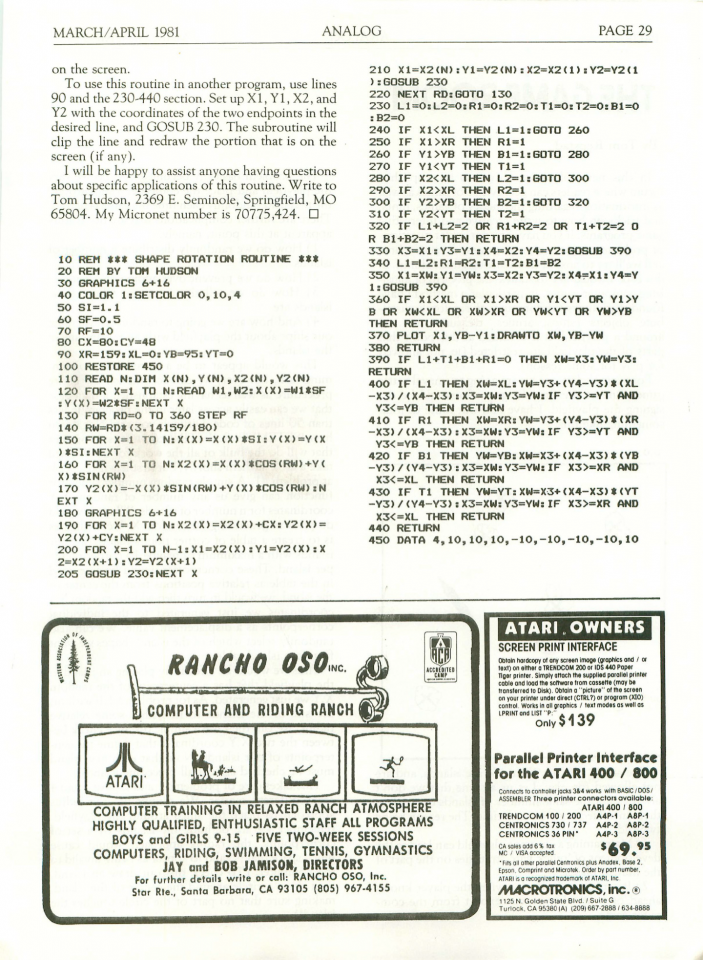
This little listing is another useful piece of code for writing games. The last one taught you how to draw Player & Missile characters. This one handles drawing off-screen without getting error messages. Now, I’m not going to enter the listing, so I’m not going to get the details about what it looks like, but I do wonder if this just has drawing off-screen, or if it will have the image wrap. Similarly, I wonder if this would allow for scrolling images – and thus scrolling levels, and thus, theoretically, I dunno, Mario for the Atari 8-bit? Commander Keen? Anyway, I’m putting the listing up as an image if you want to read it and maybe play with it.
This is meant to be a new ongoing column that will serve as a combination game design/game review column. It’s an interesting idea. I haven’t heard of any columns anywhere that connect directly connect game design theory discussion and game reviews in this fashion. Now, I just hope that they’ll try to keep the design concepts connected to the game reviews – illustrating a concept and then focusing on games that carry out that concept with varying degrees of success.
This issue they’re talking about building playfields, and in particularly randomly generating them. This is different from modern procedurally generated content. This is more of a less sophisticated Nethack – like randomly populating a Snake/Light Cycle level with some obstacles. They’re implementing this with a sort of ship battle game – we have two moving ships on-screen, a Player (the player’s ship – natch) and a Missile (the enemy ship), plus additional missiles for any shots fired by the ships. However, we want to populate the field with some islands, and to make things interesting and varied between plays, we want to randomly place them, but we don’t want them to be put on top of each other, and we don’t want to accidentally spawn a ship on top of the island. So, we get another useful subroutine for handling the generation of the playfield. This makes the third useful subroutine for designing games we’ve gotten this issue. Now, all we need next is one for collision detection, one for shooting, and one for the actual AI, and we’ll have all the pieces for a game. From that it would be just a patter of putting the pieces together.
Our next review is for another “edutainment” simulation game on par with last issue’s SCRAM. Specifically, we have Energy Czar. Your job is to regulate energy policy to meet certain environmental goals without pissing off the public so much that you get fired. This feels like the kind of game that the Atari 8-bit systems would have problem handling, but might work a little better now, in the hands of the right developer. Their reviewer like the game’s challenge, though he came in suspecting it would be terribly dull.
We also have a review of the Mosaic Memory Expansion Kit. Basically, this is a kit you can install into your system that lets you increase the amount of memory you can work with, thus making it easier to do software development. The device was actually made by a company that would have been not too far from me – Mosaic Electronics in Oregon City. Mind you, installing the memory isn’t as easy as it is with modern systems, as you have to solder the memory onto the board. Naturally, this process will void your warranty, though apparently since the system only shipped with a 90 day warranty, this might not be a problem.
As an aside, a 90 day warranty! Really? Most computers now ship with a one-year warranty! My God, and my customers when I did tech support complained when we wouldn’t do support longer than a year, saying that warranties were longer back in the day.
Next up is a review of War at Sea, a serial-numbers-filed-off port of Battleship. It’s apparently a one-player only version, though it has some interesting sound presentation, particularly with Morse code effects and some engine rumble, as well as a ticker-tape message for the winner. The reviewer things a two-player version could work, but I’m not so sure of it working for hot-seat play.
The exclamation mark was their idea.
Anyway, this listing is another useful, practical application – an app that lets you save the output from your modem to a floppy drive or, presumably, a cassette tape drive. Practical for the time, but not really useful now.
We have a review of a calculator application. Not something I’m particularly interested in. There’s also Mind Bogglers, a collection of simple puzzle games, like variants of Simon, Hunt the Wumpus (called Mystery Box), and an Othello clone.
There’s also a round-up of various first party Atari printers – an 80 column and 40 column dot matrix printer and a thermal printer. All the reviews are favorable, which is unsurprising, considering their fanboyism at this time. We do get a sample printout for each printer, which is a nice touch though.
This is another program listing of the practical sort. Apparently Atari’s own Assembler/Editor cartridge doesn’t translate Machine Language back to Basic very well, after you’ve done the original translation from Basic to Machine Language. This is something that’s kind of important, if you’re planning on selling a program to someone and you want them to be able to edit the code – something that was somewhat important at the time.
As it says, this isn’t a tutorial on how to use Atari’s Assembler/Editor. By which I mean it’s not a complete tutorial, instead covering some of the basic features of the Editor side of the app, like auto-numbering, exporting your program to a floppy disk, and so on.
I get the impression that Assembler/Editor just came out, as that’s the big running theme for this issue. They could have, in theory titled this issue “The Assembler/Editor Issue” on the cover. Anyway, the manual for Assembler/Editor said you could CLOAD code from tape (CLOAD, I presume, meaning “Code Load”). However, it doesn’t work that way – so instead they have a little subroutine they’d written to help you do that. We also have advice on what to do when you have two files with the same name (apparently this version of DOS doesn’t catch that automatically).
We get a look at some of the programs being developed by Adventure International. They published Star Trek 3.5 that was being reviewed last issue, as well as a bunch of upcoming text adventure games. Adventure International would later develop a text adventure game based on the Buckaroo Banzai film.
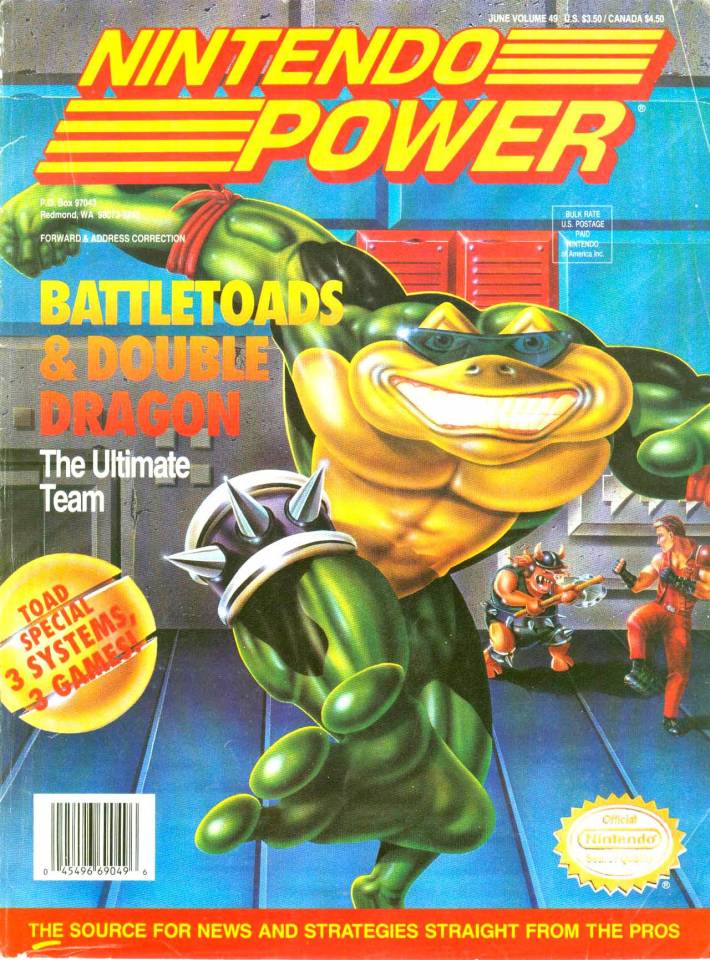
After a far too long delay, I’m finally carrying on with my Nintendo Power Recaps with issue #49 for June of 1993. Our cover story for this issue is the crossover that nobody was really anticipating – Battletoads and Double Dragon. It perhaps bears noting that it is the Battletoads which are hogging the spotlight here (no pun intended) while one of the Lee brothers is in the far background.
The letters column this issue has a request of more reviews of alternate controllers. It does bear mentioning that as we moved into the 16-bit generation, magazines dedicated less space to reviews of 3 party controllers. Gamers still knew they existed, thanks to massive numbers of ads but we didn’t get dedicated reviews of them.
This is a side scrolling run-and-gun game from E.A. for the SNES. The game follows a teenage robot who crashes his dad’s spaceship on a planet full of enemies. He has to fight through them all and make it to his date. The game incorporates falling damage, related to how quickly you fall, which is a nice touch. We get maps of stages one through six, as well as weapon and utility item notes. I’m also noticing that none of these stages have boss fights, which was probably a daring move for the time. There are some more difficult stage-specific enemies, but no set-piece boss fights, except towards the end of the game, which isn’t covered in this guide.
So, Taz Mania is running wild, Brother. Unlike other versions of Taz-Mania, this one uses Mode Seven graphics, to make this a sort of racing game, with the player standing behind Taz as he runs down roads wrecking havoc, collecting Kiwis along the way. We get maps for the first 3 stages and, due to the camera angle not allowing screen-shot maps, they’re hand drawn.
First up is Vegas Stakes for the SNES. We get info on the five different casinos you can play at, none of them officially licensed. The games are the usual games for a casino game – 5 Card Stud, Blackjack, Craps, Roulette, and Slots.
Next up is Super Caesar’s Palace, which does have an official license. This game has only one casino, but a slightly larger collection of games. In addition to the usual stuff, there’s Red Dog (draw 2 cards and then bet on whether your card will be in between the two). There’s also horse racing and keno.
Well, Yoshi’s cookie has gotten a SNES port, which means it’s time for a guide for the SNES version. Of note with the SNES version is Bullet-Proof Software, the same people who brought us Tetris, developed the game. Alexey Pajitnov even did the puzzle design..
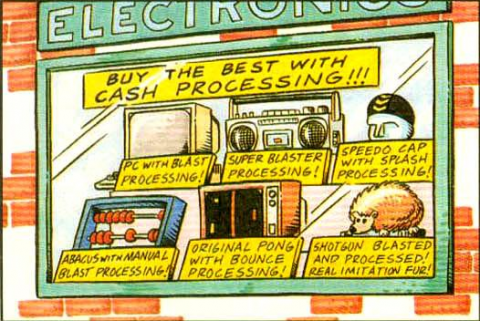
This is basically a Q&A column, with a bit of FAQ to it. We’re starting off with a surprising cheap shot at Sega and the Genesis, with their response to the question “Does the SNES have Blast Processing.” Nintendo’s response is, basically, “Sega won’t tell us what Blast Processing is in the first place, so they really can’t say. The closest they could get to a straight answer was Sega saying that developers program their games to get the most out of the console’s system resources. That’s something the SNES, and for that matter, all consoles are capable of, so if that is the real, technical definition of Blast Processing, then it’s essentially meaningless. Or Sega just didn’t tell Nintendo because they’re a competitor, and Nintendo’s just going for the blatant low blow. I’m going with the latter because we have an actual honest-to-god editorial cartoon mocking the Genesis.
Next up is a question about whether the SNES CD-Rom or the Super FX is better. I’d say the Super FX is better because it actually came out, though Nintendo says it’s apples and oranges. We get another question about the lack of first party sports games, and Nintendo decides not to give a straight answer and points to all the third-party titles instead of saying “We’re getting out of the sports games business because Madden is awesome”.
We get a question about what all the possible colors on the SNES do. Well, Timmy, they help the SNES show many different types of colors on-screen at once, including multiple objects that are the same color.
Finally, we get detailed information about the SNES’s processor speed, and then a side-by-side statistical comparison on the SNES and the Genesis in terms of processor speeds, memory and that sort of thing. As any PC hardware buff will tell you, that information is meaningless without benchmarking but even now nobody’s written benchmarking software for the SNES and Genesis. It would be interesting to see, if you wrote such an application, and were able to create cartridges for the software for the SNES and Genesis, how they would turn out.
All in all, though, this article reminds me a lot of some of the raw numbers articles from EGM that came out earlier. I wonder if it was a response to how popular such articles were.
The SNES finally gets its own Battletoads game. I should really hunt down the arcade game version of this on MAME, if for no other reason because it was dramatically more violent than the home console versions, and just to compare it to the console versions or something. We get maps for every level except the last, including the rocket-bike levels, which is a really nice touch, though you don’t get timing information. Still, if you’ve played the first Battletoads game, all the levels look pretty much the same.
Like with the other Battletoads games, this one, for the Game Boy is pretty similar to all the earlier games. You have several brawling stages, you have a jet bike stage, and you have a stage where you zip around on snakes.
This little guide covers the NES version of the game. While this version keeps some of the classic Battletoads level types – brawler, Rocket-bike, Swinging wrecking ball, it does ditch the snake level type, which is nice.
We get a run-down of various notable controllers, both first and third-party for the SNES. This includes a few 3 party controllers that are only available in Japan, like ASCII’s one-handed controller for use with Wizardry-style RPGs. Unsurprisingly, ASCII also what is basically a memory card unit for your SNES that lets you transfer your saves between games – like the Wizardry series, which ASCII also released in Japan.
This is more of a preview than anything else. We get a refresher on the gameplay mechanics of the Bubble Bobble series.
Mascot-based action platformer, and the rundown of the gameplay mechanics we get makes it clear that it doesn’t have particularly much to distinguish it from other games in the genre.
This is Konami’s fighting game for the Game Boy. We get a list of the roster and a stat breakdown. No move lists though.
Normally I don’t go into counselor’s corner much, but there’s one trick of note here – we get a 3 page spoiler-free guide (not that it matters much) for Destiny of an Emperor for the NES. For those who don’t remember, that was the Romance of the Three Kingdoms themed RPG from Capcom.
Also, for this issue’s Nester’s Adventures, Nester (playing Batman Returns) would learn to use a cape attack when a heart is in the area, if it wasn’t for the fact that Batman and Catwoman were teaming up to hit him with a logic bomb so they can go off for a hot date.
Another puzzle game for the NES gets a guide. We get maps of a few of the rooms, as well as some notes for the level creator.
I’m not going to go in-depth here, but we also get a run down on a bunch of upcoming hockey titles and, with Father’s Day coming up, we get a repeat of some hints for games that you might want to play with your dad.
For the SNES, Legend of Zelda regains the top spot, while Mario firmly retains his hold on #1 on the Game Boy and NES.
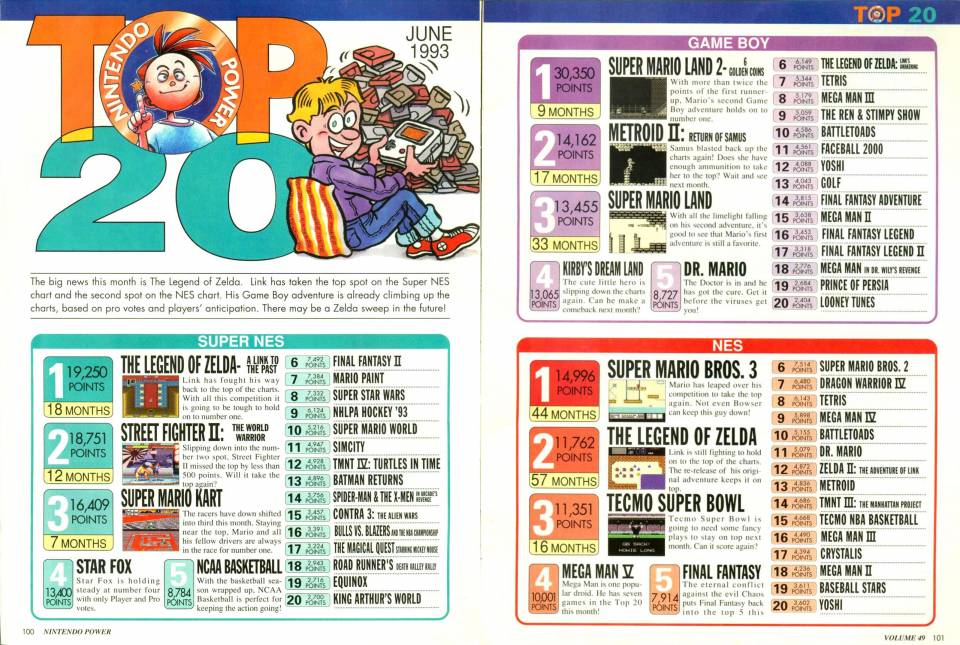
Of note among the also-rans is The Terminator for the SNES, which apparently is too easy for power-players, despite the fact that it has no continues, and it drove the Angry Video Game Nerd up the wall. There’s also Super James Pond for the SNES, and F-15 Strike Eagle for the Game Boy.
Sunsoft has an upcoming Bugs Bunny game based directly on several specific cartoons, which will likely be a future Quality Control pick. Jaleco has the fighting game Tuff E Nuff. Koei has PTO, and JVC has Dungeon Master.
So, for my Quality Control pick. I’ve already done Yoshi’s Cookie, so that’s out. I think I’ll go with Raging Fighter, just to give a Game Boy fighting game a try.
This was originally a blog post on my personal blog.

With its next episode, one of the Internet’s best retro game podcasts, Retronauts, is coming to an end. This leaves a bit of a void, as I can’t think of a lot of truly great retro game podcasts out there. Destructoid’s Retro Game Podcast, which was okay, but not great, has ended. IGN’s retro game podcast is similarly over. However, I can still think of demand for podcasts in this field, and even material that the Retronauts themselves haven’t covered yet (if only retro Wrestling video games). So, with that in mind, I’ve put some thought to the concept of what made Retronauts great, and what other podcasts (or new retro game podcasters) can do to meet or exceed the standards set by Retronauts.
Now, I’m going to stay centric to podcasts about retro video games here. There are plenty of books and web pages with general-purpose podcast advice, not to mention a really nice Dummies book on the topic.
Do a Lot of Research: This probably doesn’t bear mentioning, but I’m going to say it anyway. Do a boatload of research. Beyond what you can find in searchable articles on the internet – get old video game magazines, build a library about the video game industry, particularly with books like Game Over. However, the 1up Crew also has contacts with people who were in the game industry at the time – primary sources, if you will. If you really want to hit the pinnacle for this genre, you need to cultivate some of those.
Don’t Spend Time Bashing New Games: I listen to retro podcasts because I enjoy used games, partly out of nostalgia, and partly because many of them are very good. However, as Sturgeon’s Law says, 90% of everything is crap – even old games. Just because they’re older doesn’t mean they’re good. Additionally, just because newer games are mainstream, and trying to appeal to the “causal” market doesn’t mean they’re all dumbed down crap for babies. If you’re going to talk about old games, discuss old games. Don’t waste time complaining about how horrible new games are, and how old games are better. I don’t need nor want to listen to a bunch of grognards go on about how great everything was back in the day. If I did, I’d hang out on Dragonfoot, and listen to the Dungeons & Dragons equivalent of the Four Yorkshiremen sketch.
Do Bring Up Personal Recollections: Part of the fun of video game history is remembering what it was like for us as kids playing these kinds of video games. Consequently, personal experience playing these games and game systems as a kid is important for making discussion of these events fun, and more than just a series of historical events – though that can be fun to listen to as well.
Don’t Have A Love-In: Yes, we have fond recollections of playing classic video games as young people, and for retro games in general. However, we shouldn’t let fond memories color our discussions of them too much now. Limited continues on console games are crap. Enemies spawning out of nowhere solely to block your jump is crap game design. If you wouldn’t forgive a modern game for a similar gameplay design choice, stop before you give a classic game a pass.
Don’t Be Over Hateful: Normally I alternate my Dos and Don’ts, but here I need to have two in a row. We have the Nostalgia Critic, the Angry Video Game Nerd, and Yahtzee. They do a wonderful job of unleashing their vitriol on classic games and film (and modern games for that matter) on video. We don’t need an hour-long or longer podcast doing the same thing.
Do Get Panelists With Chemistry: Podcasts live and die by their hosts. Get people you can have a long conversation with, who you don’t always agree with, but who you can come to compromise with on various topics, particularly in your podcast. If you’ve had a long, discussion with someone about video games regularly In Real Life, then you’ll probably want them on your podcast.
Finally, Have Fun: If you and your panelists are having fun, that will carry over in your voices to the podcast you’re having. If you’re faking it, that will carry over as well. So, relax, you’re talking about video games. It’s supposed to be fun.
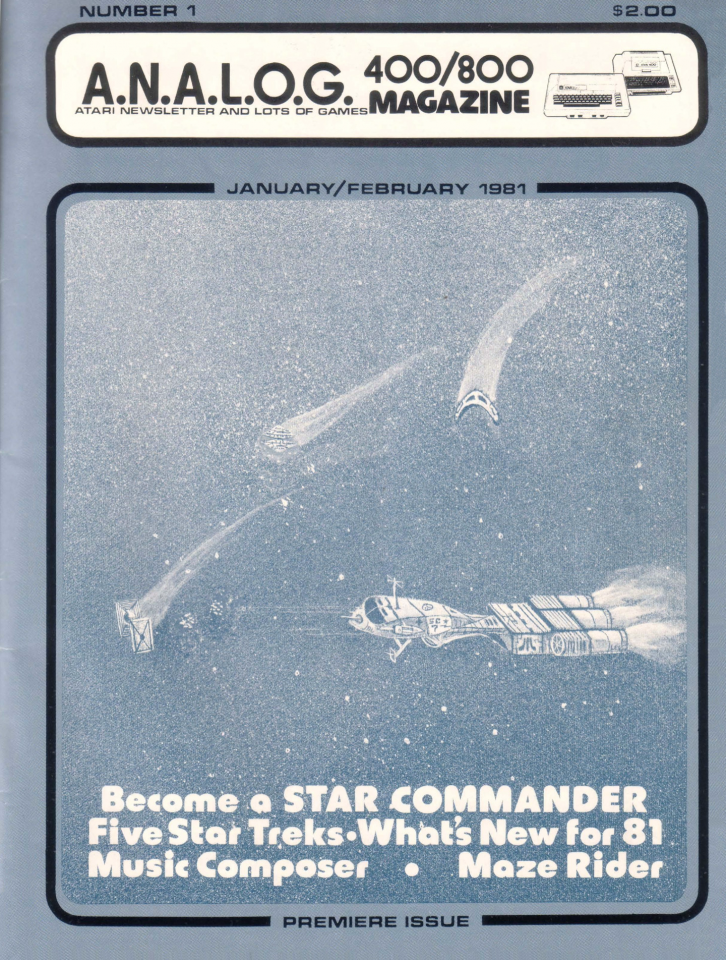
Having run out of issues of EGM for now, it's time for something completely different. Specifically, we're shifting focus from gaming consoles to computer gaming, with Analog Computing Magazine. For those unfamiliar with this magazine, it focused on computing on the Atari 400 and 800. Why am I picking this magazine? Well, because the first computer I ever used was an Atari 800, so Atari computers hold a special place in my heart over the Commodore 64. Fear not though, once I've gone through this magazine, I'll see if I can find an old Commodore magazine and give that a run through – particularly since Commodore's history is interesting in its own right.![]()
We're starting off with issue #1, for January and February of 1981. For those keeping track, this is just two years before the Video Game Crash – a bullet that hurt Atari and the 2600 badly. However, this magazine is focusing on the 400 and 800, so we'll see how badly those lines are hurt. Our first ad in the magazine is for... well, another computing magazine – Compute! Magazine. Our editors are Lee Pappas (who is now involved in mobile game development), and Michael J. Deschenes, who I can't find anything about. Michael – if you're reading this, and there are any projects you're working on that you want to plug, please feel free to plug them in the comments.
We have a rather nice editorial column to start the issue, as a letter of intent. Pappas basically explains why he wanted to start the magazine – to serve as a method of collecting useful information that was previously spread among disparate local user groups and Atari itself into one place that was easily accessible.
To put it another way for those young kids who have only known the internet – before the Internet as we know it today, when you wanted to get a lot of information out to a lot of people united by a common interest, you'd start a Zine. You and a bunch of friends, possibly members of a common user group, would write articles and format them like a magazine. However, because they weren't a lot of you, and you might not necessarily have contacts in any major publishers or hardware people yet, you wouldn't have a lot of content at first, maybe only '45 pages. Still, you'd write enough to fill a short issue, publish it, and then sell it through mail order. You might advertise through BBS services. You might send some free copies to software publishers as well to try to get them to send you stuff in return for coverage. Sometimes you couldn't cover your costs and closed your doors. Maybe you lost interest, or life got in the way. But sometimes you went big. We'll see how Analog Computing turned out.
Anyway, the magazine isn't totally game focused, as they want to give coverage to other applications as well. Depending on the apps, I may give them a try – however, don't expect me to spend time trying out VisiCalc or a word processing app.
On the games front we have home computer ports of Missile Command and Asteroids. I haven't played the home port of Missile Command, though I'm not sure how well the a joystick works in place of a track-ball for controlling that game. I have played the Asteroids port though, and it was okay, except it was easy to accidentally start your ship moving, as you were using one button to fire, and starting the ship's thrusters by pressing the joystick up or down. Our third game is Scram, a nuclear reactor simulator designed in the wake of the Three-Mile Island event.
On the more general software front, Atari is working on a new programming language called PILOT, designed for beginning programmers, similar to Logo. There also working on a series of programs-on-cassette to help users learn foreign languages. They're starting out with the Romance Languages – Spanish, English, Italian. There's also a press release about the new version of Atari's VCS system, otherwise known as the 2600.
There's a review of the Atari version of Space Invaders which is extremely favorable, but not particularly useful. The review is about three paragraphs long, and really doesn't go into a lot of details about the game itself. For example, it says something strange happens when you get 1000 points, but doesn't explain what it is, and I'm not able to hit 1000 points in the Atari 800 version of the game, so I can't find out there either. If anyone has this information, please feel free to post about it in the comments. I gave the game a try for myself, and found it's rather difficult to get to the third or fourth wave - there are no forts in this game for you to use for cover, and once the aliens have completely emerged from their mother ship, they speed up dramatically, and get faster as you kill more of them. I don't know if this was intentional, or if it was a problem inherent to the platform.
Anyway, Atari is also working on bringing gaming into the wonderful world of 3D with their COSMOS gaming system. However, the system wasn't really 3D, instead using overlays. It also was never released.
This article here is, basically, a little run-down of several of the other programming languages being used around the time this issue was published aside from just Basic. In particular, FORTRAN, COBOL. They also make it clear that in no way could those programs run on rival computers (like the TRS-80) to the 800. However, they also make it clear that those languages are meant for corporate and business environments, and have a price to reflect that, so they're too expensive to feasibly to run in the home, or even in your small business. As it is, those languages couldn't be run on the Atari 800 either, which they admit, which makes their cheap shots at the competition hilarious.
So the next language we move to is BASIC, which is less efficient, but generally more practical for use in the home, and more affordable, which is why most magazines like this one featured program listings in BASIC as opposed to other languages. However, if you want something more efficient than BASIC, but will still run on your Atari, you can try Mnemonics, a sort of Assembly Language interpreter. Assembly language is the programming language that the processor itself understands. However, you still need an assembler to translate Mnemonics into Assembly. We also get a little information about Pilot.
On a side-bar, we get an ad for an Atari version of Colossal Cave, titled simply “Adventure” for the Atari 800.
This is an ongoing column with information on how to get the most of Composer, a synthesizer application that lets you write music on your Atari 800. This installment of the column relates to sheet music, how to read it, and how to interpret it into Composer. Now while you can't get a lot of length out of your compositions, this could be a useful app for those wanting to make your chiptunes with something other than the SNES or the Game Boy.
So, you don't have Atari Music Composer and you want to make music – or if you're designing a game and want to add sound effects. Well, tear your hear out no more, as here are the commands you can use in BASIC to get the sounds you want.
As is customary for magazines of the time, we have a program listing for a game. In this case, it's a clone of snake. This is a nice little starting game for programmers as it teaches control inputs and collision detection.
There's also a review of Kurita's new graphics tablet for the Atari 800. They like it except for the price, and have a small quibble over an issue that I would consider really major – if you take to long to complete your drawing it goes into screen-saver mode (though they call it “attract mode”) and you can only clear it by using the keyboard – and if you use the keyboard you lose your work. That's a problem. We also have a review of “Mountain Shoot” - an artillery game, but without the option to get weapon upgrades.
We also have the first application on here which really gives me pause. It's an application that lets you change the font on your Atari computer. However, it does this by completely over-writing the system font, which means that the font you use will appear in all applications on your computer – including games.
Our breakdown of five Star Trek titles that was our cover story – gets one page and doesn't even get its own header. I'm actually not going to get too far into this as ultimately, most of these Star Trek games are, in essence, Star Raiders clones. There's also a combined review of Atari's new disk drive and as the new version of Atari-DOS, which uses less memory now.
This is a sort of semi-guide for Star Raiders. You don't really need it – I did just fine without it when I was a kid, but nonetheless, I'll give it a run down.
There's a glitch with the Photon Torpedo that lets it hit enemies who you don't have in your cross-hairs.
Always know your bases are, so you can quickly warp out of the system if you run into trouble.
If the enemy is going to blow up one of your bases, blow it up first, because if they blow it up, they'll get two more ships and you'll lose more points than if you blow it up.
You can fire torpedoes more quickly if one of your launchers is disabled, so if one gets destroyed, consider it a net gain.
Jumping over 5 sectors at once uses over 500 points of energy, as opposed for 250 for just 5 sectors.
Hopefully this should set you up for some high-level Star Raiders play - or something.
We get a rundown of 4 upcoming titles for the 2600, including some drawings of what it will look like (since it's rather difficult to take screen shots at this point in computer history). Specifically, we get Othello, Asteroids, Video Pinball, and Warlords. Of those games, Video Pinball and Asteroids are available on Microsoft Game Room, and you can find the relevant gameplay videos in Jeff's Game Room Update videos.
This is a maze navigation game, one which doesn't show the entire maze at once. Instead you have to navigate the maze while only being able to see the map three times. Unfortunately, the game's perspective isn't clear – whether you can still see a small slice of the maze, or whether it's in the first person perspective.
Earlier this issue, we got information about how make sounds in basic. This article provides information about how to draw pictures in basic, and even make them in color. We also get a few simple grids to give you some an idea on how you can plot out your graphics in advance. I can't help but feel like this article would work better if there were screen shots to help put the code samples in context.
There's a review of Atari's new stock and bond analysis application. Now, these applications do not use a dial-up modem to retrieve stock listing information. Instead you have to enter that information manually, and use that to compare information. One application that definitely hasn't aged well. In a similar vein, Atari has their Mailing List application, which helps you keep track of your Rolodex, and has been replaced by most mail applications address books.
Well, this is a column that wears its fanboyism on its sleeve – the writer outright says that because this magazine only covers Atari computers, and because Atari computers are the best computers on the planet, bar none and are perfect, this column will be short-lived. That said, they do give us one problem fix here. If your computer is slow booting up and presenting a ready screen, there might be oxidation forming around the connectors for the memory, in which case you - or at technician - will need to take out the memory, clean the connectors, and then re-seat it. Apparently newer systems will have gold connectors, which won't have that problem.
Also, they recommend listing or running your program regularly when working on it, so you don't lose your work and the system doesn't lock up. We also get a short program to tell if your system has a bad bit, by making the computer draw a solid color circle – if there's a bad bit in your memory, you'll have a dead pixel.
I'm not precisely sure how this game works, as there is no picture. You control a sub and you're trying to clear mines, but there's also a gunboat that's controlled by the computer. Anyway, it's a pretty short program.
We have a review of Lunar Lander. They like the game, though they don't like the lack of a title screen, or any sort of difficulty options – once you start the game you're playing. Additionally, the game doesn't automatically shift to a closer-to-the-ground perspective like with the arcade game.
So, that concludes this issue of Analog Computing. It's a nice start. I do hope that as the magazine goes on the fanboyism gets toned down a little bit, and eventually they figure out a good way to take screen shots - oh, and they become more willing to write negative reviews of stuff - which will hopefully happen as they bring in more income and no longer have to depend on review copies of stuff.
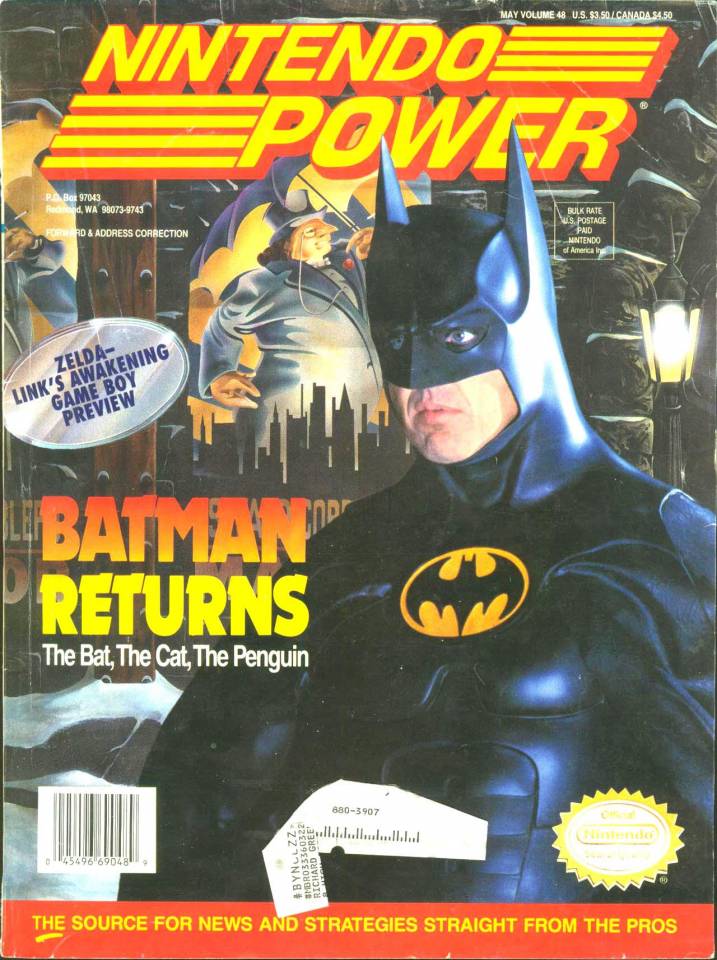
We're moving on with the Nintendo Power Recaps with issue #48 for May of 1993. Our cover story for this issue is the beat-em-up adaptation of the Batman Returns film. Our letter themed topic for this issue is suggestions for contests. The prizes that are printed seem pretty reasonable. We have one writer who suggests a Wrestlemania themed contest, with the winner getting a trip to Wrestlemania IX, second prize being a Super Wrestlemania Game Pak and a years subscription to WWF magazine, and the runners up getting Nintendo Power jackets. Another reasonable one is a trip to a snowboarding championship (have the X-Games started yet?), with the winner getting a meet-and-greet with the contestants, as well as snowboarding lessons from the winner.
We have the first appearance of Blizzard Entertainment in Nintendo Power. Okay, that's not technically true – at this time Blizzard was known as Silicon and Synapse. For those unfamiliar with the game, you control three vikings, Eric the Swift, Baelog the Fierce, and Olaf the Stout. They were abducted by aliens and now need to escape. Eric can run fast and bash through walls with his head. Baelog is the main combatant, and Olaf is very hard to move, but he can also glide using his shield.
We get a run down of various character combinations and tricks that can be done. For example. Olaf can be used to ward off enemies, while Baelog kills them with arrows. Baelog can also use his bow to trigger buttons from afar. Eric can reach higher areas by standing on Olaf's shield. Characters can also leap down onto Olaf's shield to cushion their fall. In certain levels, Baelog can also set his arrows on fire.
We get a map of Stage 3 from Stages 1 through 4, which make up the stages on the space ship. Stages 5 through 11 are set in the prehistoric period, with the Vikings fending off various dinosaurs and other enemies, and from this section there's a map of stage 9. Stages 12 through 17 are set in ancient Egypt, and from here we get a map of stage 12, and introduces guards who can leap over Olaf, which means the position of Baelog behind Olaf is important, and he'll have to do more sword-work than archery. Stages 18 through 25 are set in a modern factory, and has more automated environmental hazards. From this section we get a map of level 18. Stages 26 through 33 are set in “Wonderland,” a world which follows something closer to cartoon physics. Our map is of stage 26. Finally Stages 34 through 36 are back on the alien space ship, and conclude with the vikings taking on the alien's leader, Tomator. Our map is of stage 34.
This is a feature article giving brief previews over various sports games, without doing a full in-depth review.
We get a run down of some more upcoming sports titles, including Tecmo Super NBA Basketball. The game has 27 teams and a battery backup for saves, which is nice, though password support has it's advantages – namely it makes it easier to play any match-up whenever you want, if you know the password. Acclaim has an American Gladiators game which apparently isn't very good. We also have Magic Johnson's Super Slam Dunk from Virgin Games – which apparently has two gameplay modes – exhibition and playoff, but you can't choose your teams in playoff, which doesn't make any sense to me.
There's also a profile of Test Drive II: The Duel, a racing game where you have a choice of three different licenced supercars – the Porsche 959, Lamborghini Diablo, and the Ferrari F-40. I played Test Drive V and thought it was okay except for the rubber band AI but I never played a SNES racing game. This sounds kind of fun and I might give it a try.
Hudson Soft has Super Battle Grand Prix , a Formula 1 racing game. Midway has Super High Impact , an arcade style football game, which I'd describe as an 16-bit NFL Blitz , but without the NFL license. There's also American Sammy's arcade style football game The Pound and the Fury , which is quite possibly the dumbest pun I've ever seen in the title of a football game, and it doesn't even make sense in the context of a football game. Seriously, whoever came up with that pun needs to get dope-slapped, and I like puns. Finally, we get a look Konami's NFL Football , which kind of gets semi-panned as well, but they're not too down on otherwise.
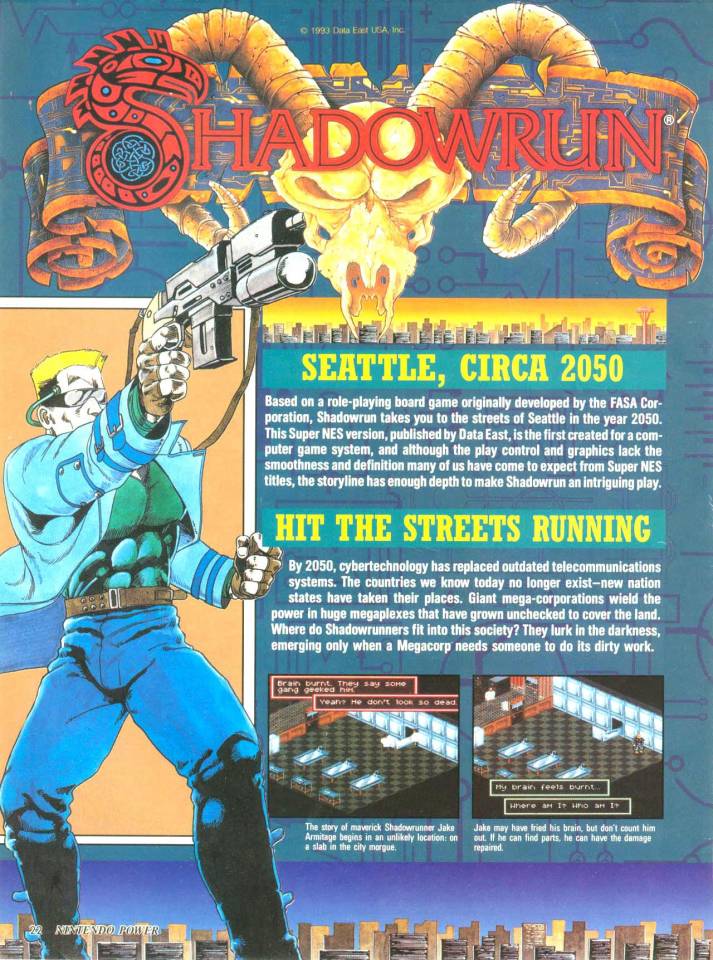
Here we go. This and the Genesis Shadowrun game are probably two of the best adaptations of game by FASA out there. I absolutely loved this game, and it's a game I beat – I used an emulator, but I beat it. (I didn't use an invulnerability cheat, but I did use an unlimited ammo and money cheat). The article does erroneously refer to Shadowrun as being a “board game”, but it otherwise provide appropriate credit. Plus, to be fair, at the time the other game FASA was famous for, Battletech, was a miniatures game.
My main complaint with the game is that some fights and puzzles are pretty pixel-bitchy. However, from a narrative standpoint, it's better then the Genesis version, which trots out a Deus Ex Machina solution for the end of the game, where your hoop gets saved by an NPC you worked with earlier in the game – essentially the GM's pet NPC. Anyway, the guide takes us through to the Drake Building, but not much further than that. To be fair though, that's pretty far in the game.
We continue on to this guide for the new Batman brawler, though I'm not totally sure why we need a guide for a brawler. We get a run down of the different types of enemies (Thin Clown, Fat Clown, Biker, Bazooka Clown, Fire Clown, Tall Clown, Swords Swallower, and Knife Thrower), and power ups (health power-ups, explosive grenades, and extra points). We get maps of every stage in the game and their respective bosses.
We get a really big poster for Bubsy, before we get to another Nester's Adventures, this time for Mechwarrior, where Nester learns the importance of watching his heat levels.
Well, in the last issue of EGM I recapped we had that year's game of the year's award ballot. Well, this issue of Nintendo Power has the nominees for the year's Nester Awards. This time, since there isn't a lot of analysis to do at the moment, I'm going to just post the relevant pages then give my picks.
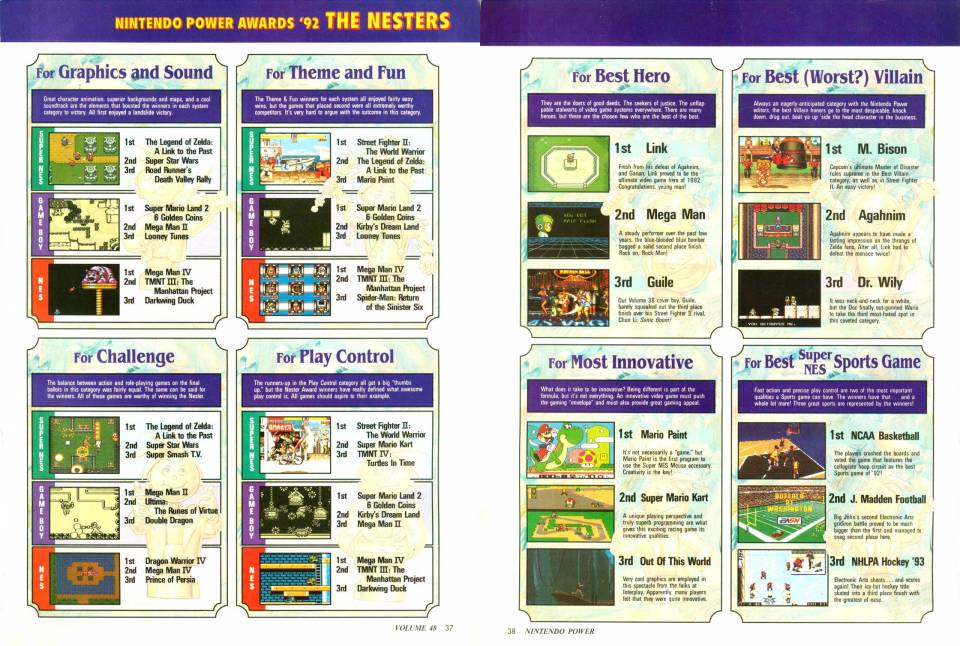
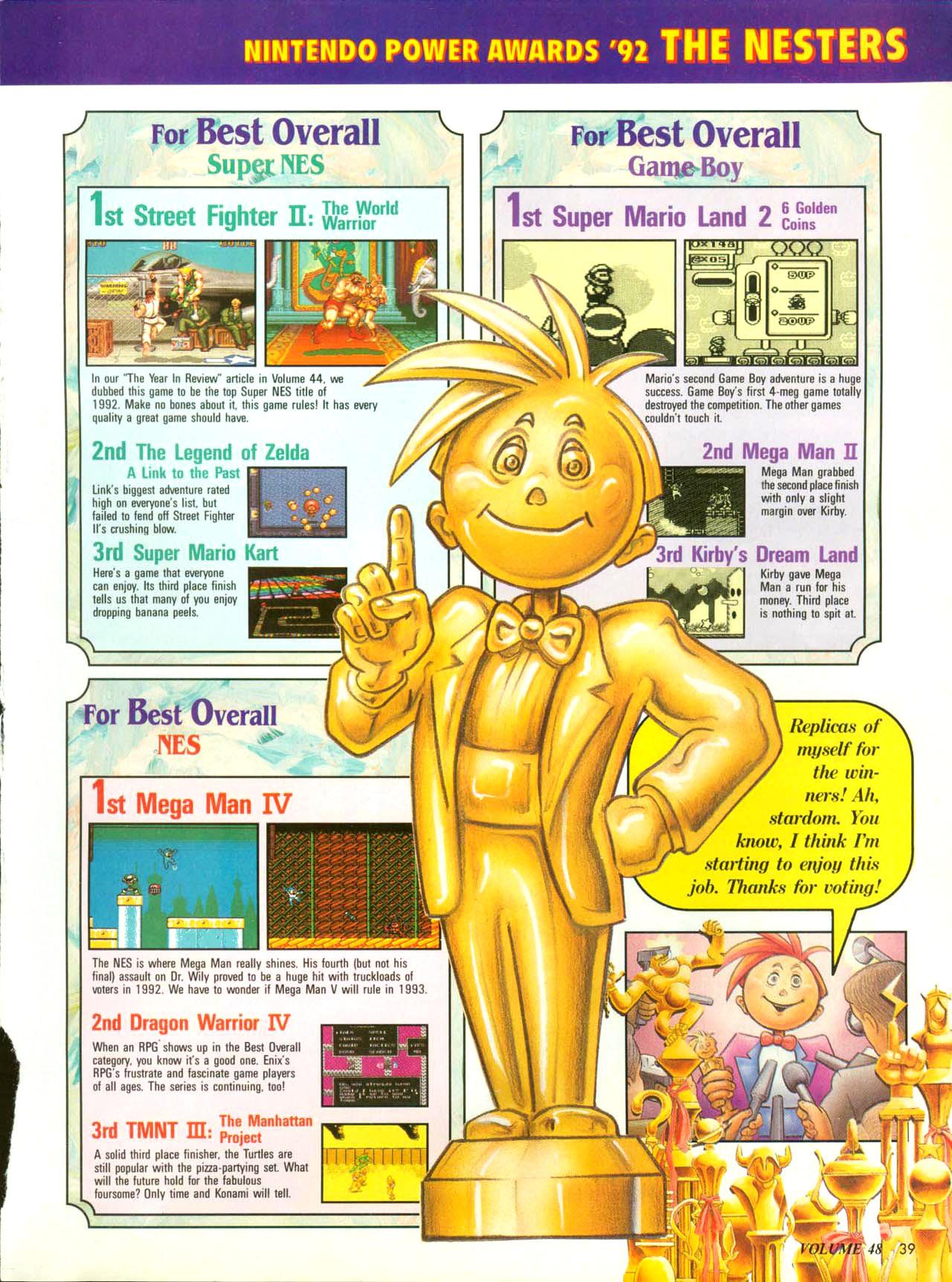
Graphics and Sound
SNES: A Link to the Past
Game Boy: Super Mario Land II
NES: Mega Man IV
Theme and Fun
SNES: Street Fighter II
Game Boy: Super Mario Land II
NES: Mega Man IV
Challenge
SNES: Super Star Wars
Game Boy: Mega Man II
NES: Prince of Persia
Play Control
SNES: Street Fighter II
Game Boy: Super Mario Land II
NES: Mega Man IV
Best Hero: Mega Man
Best Villain: Dr. Wily
Most Innovative: Out of this World
Best SNES Spots Game: New York Abstains, Courteously.
Best Overall Game:
SNES: Street Fighter II
Game Boy: Kirby's Dream Land
NES: Dragon Warrior IV
We get the continuation of the Star Fox comic, but it's still dumb, so I'm just gonna skip it.
We get a run down of the new characters in this game, as well as the new gameplay mechanics (the ability to jump, and a block option). We also get a brief description of the goal of the game – to retrieve the 8 musical instruments required to wake the wind fish.
This is a Game Boy port of the NES game, which, for those who don't recall, can essentially be described as the Teenage Mutant Ninja Turtles meets Captain Planet. We get maps of all five levels, as well as strategies for the boss fights.
This game is sort of an odd mix of MMA and pro wrestling. It almost feels like the kind of odd mix that would come out of the Fire Pro series, but not really.
This is an RPG from Namco with a name that Gordon Gekko would love. It also doesn't look particularly interesting.
This is your first look dear reader, at the Mario Bros. Movie. The article also sends one message, and sends that loud and clear - “Run away, run away!” That said, for some bizarre reason, someone bothered to give this film a budget, like
Moving on to the NES, we've moved on to Kirby's first home console game. We get maps of the first 4 stages, as well as advice for boss fights, and there are 3 more levels after that.
This is based on the line of licensed toys which appear to be designed so you lose pieces. We get maps of the first two Worlds.
This is a NES port of the SNES game. We get a map of the first stages of Worlds 1 through 3 (but not the subsequent stages of each World).
Our number one games for the SNES, Game Boy, and NES respectively, are Street Fighter II, Super Mario Land 2, and The Legend of Zelda.
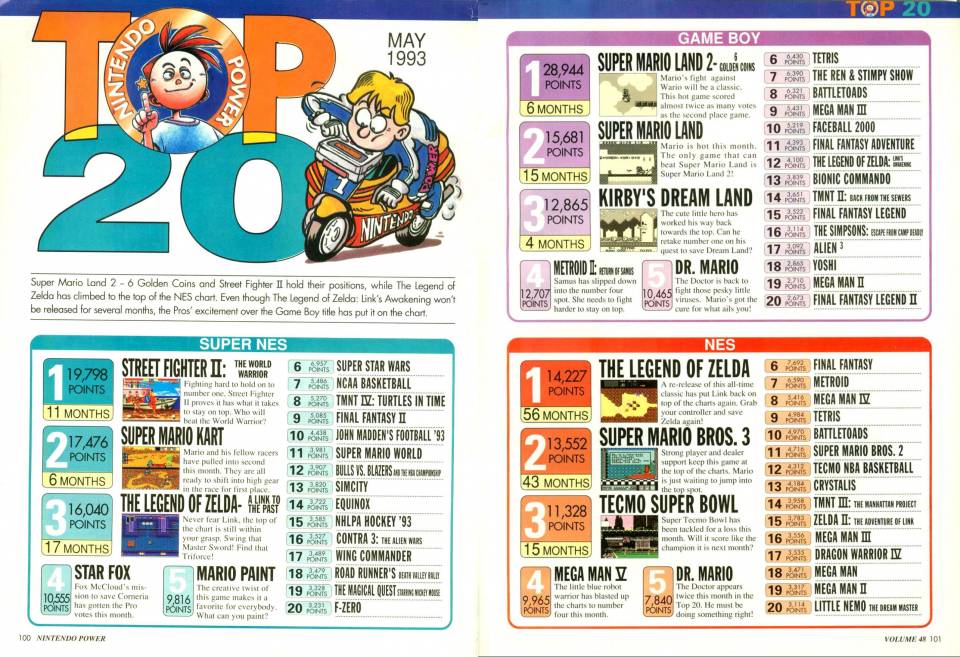
Of note in the also-rans is the anime-style action game Kendo Rage, which looks interesting. In Pak Watch we get a look at Final Fight II, Alien 3, which I've discussed previously.
Finally, my Quality Control Pick. I know the Test Drive series gets a bunch of sequels, so I'm not going for that one. Instead, I'm going to take Kendo Rage, just because I haven't played something really different for some time.
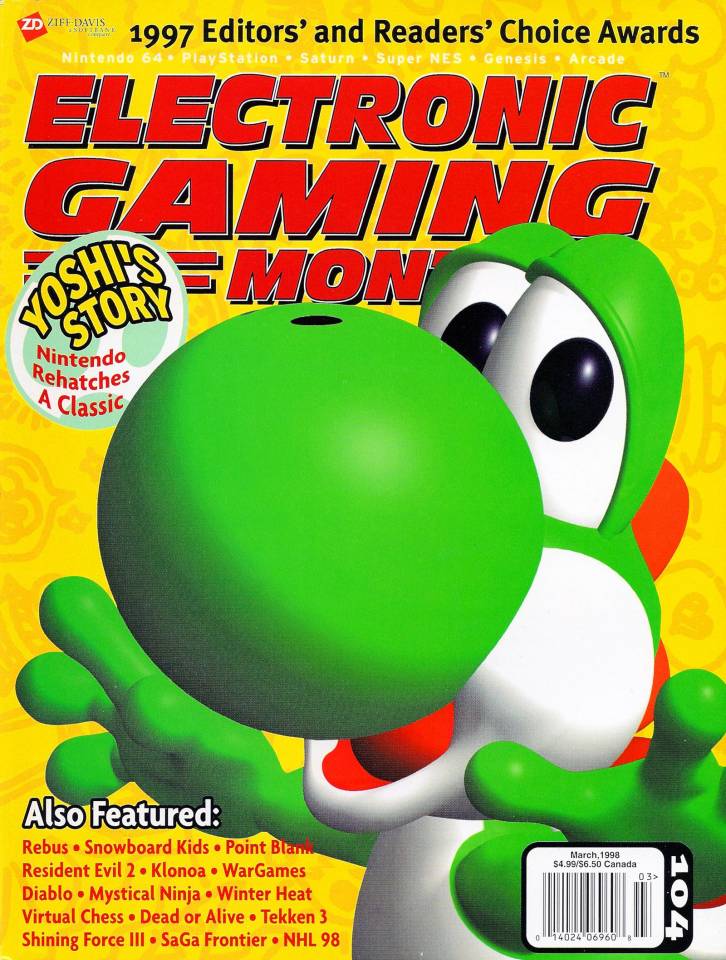
I've found one more gap that I can fill in my Electronic Gaming Monthly Recaps – with issue 104 for March of 1998. Our cover story for this issue is Yoshi's Story for the N64. This issue also has the absolute dumbest ad for Klonoa ever – in that it deliberately tries to draw a connection between the main character of the game and blood-borne pathogens of the sexually transmitted variety. Yeah.
Our editorial column for this issue is from Editorial Director Joe Funk, about starting a retro gaming section in the magazine. If it weren't for the fact that thus far this blog has been covering retro games rather heavily, I'd be all for it. Actually, that said, one of my favorite bits from Game Informer Magazine is when they'd review one old game they hadn't reviewed before, and then re-review an old game that they had previously reviewed, to give the game a modern perspective. Ultimately though, they're not going to run a retro gaming column at this time, just for space constraints.
We also get a very nice two-page ad for Final Fantasy Tactics.
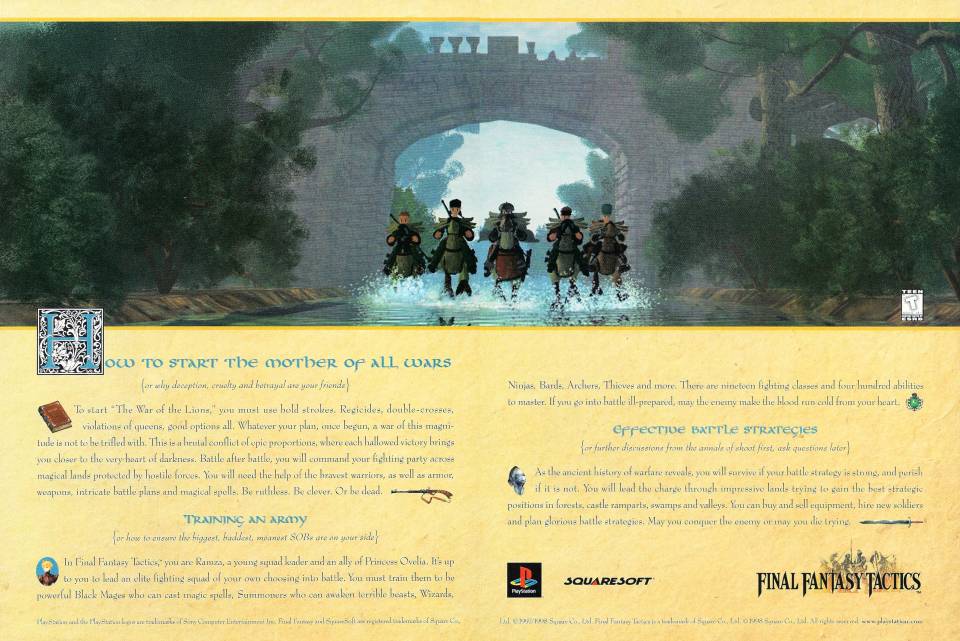
We have a letter wishing everyone some rather odd holiday wishes. If they still did the Psycho Letter of the Month, I'd think this letter would qualify. However, our letter of the month is much better, and focuses on the concept of game endings, and game length. In particular, game design philosophy. The writer comments that a lot of prior game designers – even when they were working on a game for the home, were still operating from an arcade game mindset – where rather then designing a game experience to be ultimately a cohesive whole from a storytelling standpoint, instead they were trying to build a game from the mindset of an arcade game.
Let me put it another way. The pacing of most modern video games is determined by the narrative. The story determines how long the game is going to be, and how long the levels are. On the other hand, older games borrowed the arcade game standpoint for game length – the game could be played through entirely in one sitting. However, the game would make it difficult to play through the game in one sitting through various factors. The difficulty of the levels would make it difficult to get through them without practice and memorization. Additionally, on home consoles the player would have limited lives and limited continues, forcing them to start over from the beginning at a certain point, etc. So, with the new focus on narrative on modern consoles, the way games are paced now has to change to reflect the narrative. However, because this is kind of new to them, it's going to take it a bit, which is why, at the moment, games are kinda short.
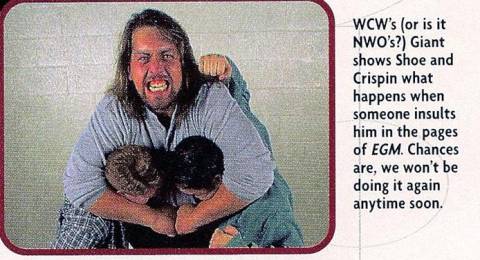
Oh, and we get a picture of Paul “The Big Show” Wright (then wrestling in WCW as “The Giant”) putting Crispin Boyer and Dan “Shoe” Hsu in headlocks. As a fan of The Big Show, I approve of this.
Sega is in trouble, and we get an analysis piece on why. The Saturn did poorly, but was neglected from a first party software standpoint, and was ultimately sabotaged by Sega's marketing department – who probably, at this time, would fit the Sirius Cybernetics Corporation Definition of “A Bunch Of Mindless Jerks Who Will Be The First Against The Wall When The Revolution Comes.” It doesn't help that Bernie Stolar, then head of Sega already declared the Saturn dead at their E3 Press Briefing, with no explanation of what would be taking it's place. You'd think they would have learned something from Commodore.
For those unfamiliar, Commodore's downfall was basically expedited by the following words being repeatedly said by the Marketing Department: “If you think this model is great, just wait until the next model.” This in turn lead to the Engineering department devising elaborate revenge fantasies against the Marketing department for forcing them to do even more work. Meanwhile, the Sales department has much more mundane fantasies about killing off the Marketing Department ala Joe Pesci in Casino , due to Marketing costing them sales.
Anyway, we get notes on the planned Mortal Kombat Live Action series, which does rather poorly, though it does manage to survive for a season. There's also a note about Nintendo starting a greatest hits line of titles, and also pushing a few titles back – notably Banjo-Kazooie, Legend of Zelda: Ocarina of Time, and F-Zero X.
It seems we're still getting two CES events a year, as they've just had Winter CES in Las Vegas, Nevada, spread between several hotels. From prior experience, having your convention spread among several buildings is a bloody nuisance for attendees. The big thing on display at that year's CES was the new HDTV technology, being pushed by DirectTV, which was demoed on the show floor. More DVD players were also demoed, and the Divx disk format is officially dead in the water.
Oh, and we've gotten the Pokemon Anime Seizure mess, which for some bizarre reason, lead to American news outlets (particularly Fox News – no surprise there) making a big deal about how horribly violent Japanese anime is, because of flashing colors – with the then-programming director of Cartoon Network, Mike Lazzo (creator of Aqua Teen Hunger Force) taking pot shots at Anime in USA Today. Of note, he says that anime is edgier and more violent, and less focused on story. Really. And how is “Aqua Teen Hunger Force” better from a narrative standpoint than, say, Cowboy Bebop? Or Legend of the Galactic Heroes? How about the original Mobile Suit Gundam?
Or how about you just pour yourself a nice cup of Shut The Fuck Up.
Anyway, moving on to Quartermann's rumors, we have word that we're not going to get the N64DD in the US. Further, because the N64DD isn't getting a US release, Nintendo's stretching out their release schedule to cover this. Meanwhile, Capcom is going to be releasing Puzzle Fighter and Vampire Savior (the latest Darkstalkers game) in the US. Frankly, I was never really able to get into the Darkstalkers series of fighting games. The animations and speed of the game seemed too sluggish and clunky to me. Oh, and Street Fighter Alpha 3 is going to feature the return of Guile, Blanka, and E. Honda (as well as the introduction of Rainbow Mika).
First up is our preview of the N64's installment in the Legend of The Mystical Ninja series, titled Mystical Ninja Featuring Goemon . The game's plot apparently features an invasion of aliens in space ships shaped like peaches (which I presume is a reference to the character of Momotarō from Urusei Yatsura, which was in turn a reference to the Japanese legend of Momotarō). Acclaim has another NHL game for the N64, and Titus has their own little version of Battle Chess for the same system, which lets you rotate the camera any which way you want.
In Japan, the Saturn is getting Shining Force III. The US, however, doesn't get it, which means if you want it you have to import it. Or find a translated ROM. There's also a sequel to the sports game DecAthlete, titled Winter Heat. There's also the strategy RPG Dragon Force II , which has already been confirmed to not be getting a US release, with Working Designs not even touching it, which makes sense, since it probably makes more financial sense to focus on supporting the PlayStation over the Saturn, which Sega has officially declared to be a dead end system.
Anyway, there's also the Saturn Dungeons & Dragons Collection , and the Strategy RPG Solo Crisis from Quintet. What I want to know is, how many party members can you have in this game. Just one or multiple party members?
On the PlayStation we have a port of Diablo that doesn't work well with multi-page memory cards. There's also a look at Need For Speed III , and word that the PlayStation version of Tekken 3 will include the character of Gon, which can best be described as the biggest pain in the ass in the history of the series, due to the fact that he can hit you with everything, while you can only hit him with low attacks. I wonder if Tekken 3 is the game that turned Tomonobu Itagaki off of the series.
Interplay has the action game Heart of Darkness , which unfortunately has nothing to do with the Joseph Conrad novel, and the sci-fi vehicular shooter Crime Killer . Of particular note we get our first screen shots of Grand Theft Auto for the PlayStation. Oh, and funny that I mentioned Itagaki earlier, as we get, thus far, our first ad for Dead or Alive . We also get a preview for it which confirms that the (ahem) physics were there from the beginning. Oh, and there's the racing game Running Wild which changes up the cart-racing formula by just having it be a foot race.
There's also a look at Bloody Roar , which I played a lot of at a friend's house when I was in High School. The preview says that the game has the ability to expand the fight to new areas by beating down barriers, which is different then how it turned out in the final game. In the final game – you had ringside barriers you could incorporate into juggles for additional damage, until they were broken. Then you could get a ring-out. Atlus has the strategy RPG Rebus , which I'd never heard of before, mainly because they retitled it Legend of Kartia or Kartia: The Word of Fate for its US release.
There's also a preview of Tactics Ogre: Let Us Cling Together , which is finally getting a re-release for the PS3. On a less significant note, MGM Interactive is putting out a vehicular action game with the WarGames movie license. Odd, but I don't recall Matthew Broderick driving a tank around and blowing stuff up in the film. Acclaim is working on Jeremy McGrath Supercross '98 . For the record, I have no idea who Jeremy McGrath is. EA's also working on a ReBoot licensed game – a concept which seems delightfully meta. Oh, and Square has SaGa Frontier , which is probably one of the best games in the SaGa series. Taito's also putting out Darius-G , the latest shump in their Darius series, and which I suspect is a port of Darius Gaiden . Finally, in arcades, the first Marvel Vs. Capcom game is just about ready to come out.
We have our first in-depth look at Yoshi's Story for the N64. We get a brief run down of the game's story before moving on to what really counts for Nintendo Games (since, really, when's the last time you bought a Mario game for the Story) – the gameplay. The game apparently looks good and, I'm noticing for the first time that the preview considers the game's 60 FPS frame rate to be a big deal. Previously, while framerate would be a factor in reviews, hard numbers would never particularly be brought up, particularly due to size of the review. That said, the fact that hardcore gamers are also starting to become Audio Video nerds around this time is probably a factor.
Anyway, from a gameplay standpoint, the game's been dumbed down a bit. You can't ricochet your shots anymore, which takes out a fair bit of the strategy. Additionally, the total number of stages has been dropped from 54 to 24, which is also a bit of a bummer, considering the increased storage capacity of N64 Cartridges, and the fact that this game is a 2D platformer, instead of a 3D game. If this was a 3D platformer, I probably would have cut it more slack.
We have our Editor's Choice Awards, which is interesting in that normally we get Editor's Choice Awards and Reader's Choice Awards in January or February. Anyway, I'll put the winners as a list.
Best Overall Game : Goldeneye 64. Runners-up : Castlevania: Symphony of the Night and Final Fantasy VII. Analysis : I have to disagree with this one, as Symphony of the Night and Final Fantasy VII have aged better. While Goldeneye 64 is fondly remembered and is getting a remake for the Wii, the original hasn't aged very well (and opinion I've heard echoed elsewhere), while SotN and FFVII are still very playable.
Best Game for the N64: Goldeneye 64. Runners-up: International Superstar Soccer 64. Analysis : I haven't played ISS 64, but this could be a situation where there wasn't a lot of compeition.
Best Game for the Playstation: Castlevania: Symphony of the Night. Runners-up: Final Fantasy VII and Colony Wars. Analysis: No objection here.
Best Game for the Saturn: Saturn Bomberman. Runners-up: Street Fighter Collection, Madden '98. Analysis: Bomberman is and Street Fighter are, frankly, two games which can keep a party entertained. If you keep the rotation going, you can get a crowd of people gathered around the TV, laughing, jeering, and talking smack. Consequently, I can't argue with either of those just with the information I have (I haven't specifically played Saturn Bomberman myself though).
Arcade Game Of The Year: NFL Blitz. Runners-up: Tekken 3 and The Lost World: Jurassic Park. Analysis: I'm not much for sports arcade games. But I did like Tekken 3 and I would have given the award to that.
Action Game of the Year: Goldeneye. Runners-up : Symphony of the Night. Analysis : As mentioned previously, I'd have gone with SotN.
Sports Game of the Year: International Superstar Soccer 64. Runners-up: Madden '98, NFL Gameday '98. Analysis: I'm not going to judge this category, as I'm not much for sports games.
Fighting Game of the Year: Street Fighter Collection. Runners-up: Street Fighter EX Plus Alpha, Soul Blade. Analysis: Considering the winning game contains two solid ports of Street Fighter II as well as a port of Street Fighter Alpha II , I can't argue with this pick.
Racing Game of the Year: Diddy Kong Racing. Runners-up: Rage Racer & NASCAR '98. Analysis: There had to be a better racing game out there this year.
Role-Playing Game of the Year: Final Fantasy VII. Runners-up: Wild Arms and Alundra. Analysis: No complaints here.
Side-Scrolling Game of the Year: Castlevania: Symphony of the Night. Runner-up: Mega Man X4. Analysis: No complaint.
Adventure Game of the Year: Tomb Raider II. Runner-Up: Enemy Zero. Analysis: Being that I've never heard of Enemy Zero, I'm siding with Tomb Raider.
Shooter of the Year: Starfox 64. Runner-up: RayStorm. Analysis : Again, no complaint here.
Strategy Game of the Year: Command & Conquer: Red Alert. Runners-up: Warcraft II and Vandal Hearts. Analysis: In my opinion, RTS games just don't work very well on consoles – particularly ones without at least one analog stick, since an analog stick is the closest you'll get to a mouse. Consequently, I would have given the award to Vandal Hearts.
Multiplayer Game of the Year: Saturn Bomberman. Runners-up: Goldeneye, Mario Kart 64. Analysis : No problem with this one, and I wouldn't have complained with Mario Kart either.
Light Gun Game of the Year: Time Crisis. Analysis: If there's no one else in the running then I can't argue with this.
First Person Shooter of the Year: Goldeneye. Analysis: Aside from the fact that there were no runners up, I honestly can't think of another FPS that was released this year.
Puzzle Game of the Year: Bust-A-Move 3. Runners-up: Super Puzzle Fighter II, Intelligent Qube. Analysis: The Bust-A-Move series has been solid overall, so I can't complain on this one.
Most Original Game of the Year: PaRappa the Rapper. Runners-up: Monster Rancher, Blast Corps. Analysis : While I'm not going to say that PaRappa was the first rhythm game ever, it's certainly different from most other takes on the genre.
Best Graphics: Final Fantasy VII. Runners-up: Colony Wars, Oddworld: Abe's Oddyssey. Analysis: While I like Final Fantasy VII, Oddworld had better graphics.
Best Mascot: PaRappa. Runners-up: Lara Croft, Crash Bandicoot. Analysis: I have no complaints here.
Best Music: PaRappa the Rapper. Runners-up: Symphony of the Night, Soul Blade. Analysis: While I have no complaints over PaRappa winning, I do think that Final Fantasy VII should have been in the runners up.
Sound: Oddworld: Abe's Oddyssey. Runners-up: Goldeneye, Colony Wars. Analysis: No objections here – Oddworld depends a lot on its sound, and the sound quality here makes the game.
Best Peripheral : The Rumble Pack. Runners-up: The Namco GunCon, The Dual-Shock. Analysis: No complaints here.
Best Compilation: Street Fighter Collection. Runners-up: Namco Museum Vol. 3, Arcade's Greatest Hits: Midway Collection 2. Analysis: Again, no complaints here.
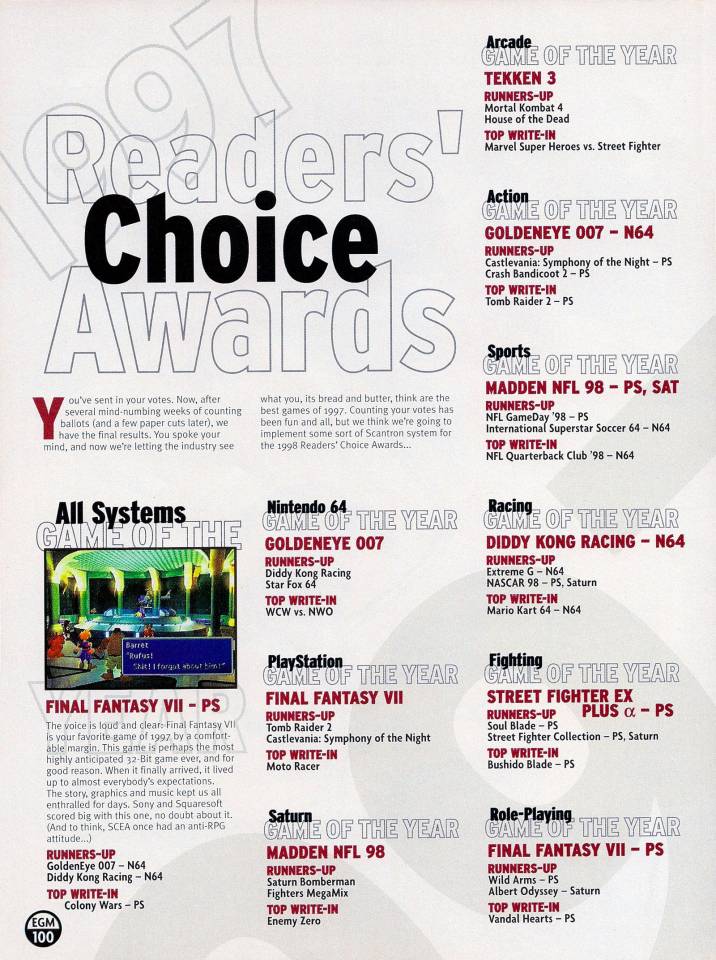
We also get our Reader's Choice Awards, but because this is getting long, I'm just going to post a scan for their results.
We get a look at the next generation of arcades, starting with the GameWorks arcade in Seattle, started by Steven Spielberg (just in case you thought his interest in video games with Boom Blocks was new to him). Basically, the concepts of this wave of arcades is that in addition to including your standard arcade games, they'll also include games you'll only be able to play at arcades due to stuff with the interface or various other things, known as Location Based Entertainment, or LBE for short.
The article puts it's focus on the GameWorks series of arcades. In addition to the use of LBE, they also dump tokens in favor of smart cards that you pre-load with a certain amount of cash. They also discuss the Dave and Buster's chain.
Anyway, of these chains, GameWorks still exists, as does Dave and Busters. As I live in Oregon, I have access to neither of these. However, we do have Ground Kontrol in Downtown Portland, and the Family Fun Center in Wilsonville.
Our review crew for this issue is Shawn Smith, Dan “Shoe” Hsu, Crispin Boyer, Kraig Kujawa, John Riccardi, Kelly Rickards, Sushi-X, and guest reviewer News Editor Chris Johnson.
Aerogauge (N64, ASCII) : This wants to be a hella-awesome futuristic racer like Wipeout. It gets the Futuristic Racer part right. The game has some major pop-up problems, which is a big deal when you're playing a racing game. Kraig and Shawn give it 5s, with Sushi giving a 6, and Kelly a 6.5. Overall : 22.5/40.
Fighters Destiny (N64, Ocean) : This is the N64's attempt at a fighting game. The crew is impressed with how the game implements a scoring system that requires the player to win by points in addition to beating the tar out of the other guy. Also, your fighter can also learn new moves by beating a boss. Even with the average graphics the game gets some decent scores. Dan gives it a 7 and Sushi gives it a 7.5. Crispin and Chris give it 6s. Overall : 26.5/40.
Jeopardy (N64, Gametek) : Well, it's Jeopardy. It also has serious problems with questions repeating as it doesn't remember what questions you've already answered, as well as really anal spelling for answers. All of this leads to a poor gameplay experience – Crispin give the game a 3, Shawn a 3.5, John a 4, and Dan a 5. Overall : 15.5/40.
Nagano Olympics '98 (N64, Konami) : Another Olympic Year, another Olympic video game. Unfortunately for this game, the Crew isn't too impressed with it. They fault the game for no simultaneous multi-player in the events (though to be fair, I can't think of any games in this genre to have simultaneous multi-player), and sluggish gameplay. Crispin and Shawn give it 4.5s, Kraig gives it a 5, and Kelly gives it a 5.5. Overall : 19/40.
Olympic Hockey '98 (N64, Midway) : This should, in theory, have a great deal of potential. It doesn't capitalize on it though, as it's identical to Wayne Gretsky's Hockey '98, with all the same flaws as the original, with re-skinned arenas and different teams. Sushi and Shawn give the game 5s, with Kraig giving it a 5.5, and John giving it a 3. Overall : 18.5/40.
Snowboard Kids (N64, Atlus) : Downhill snowboarding racing game. The Crew applauds it's multi-player, and how it handles power-ups in the game (like in Mario Kart, racers further back get more better power-ups). Actually, the whole crew compares the game favorably with Mario Kart. John and Dan give it 8s, Crispin and Shawn give it 8.5s. Overall : 33/40 and it receives an Editor's Choice Silver Award.
FIFA – Road to the World Cup '98 (Saturn, EA) : Dan thinks the gameplay, both in terms of control and physics for this game is rock solid. However, he considers the graphics to be atrocious and gives the game a 6.5. Everyone else laments the fact that this will be the series final installment on the Saturn, and likes the game and expresses all the potential the series had to be come even better in the future, with Kraig giving a 6.5, and Kelly and John giving the game 7s. Overall : 27/40.
NBA Live '98 (Saturn, EA) : Kraig and John has some problems with this version of the game's sound quality and graphics, and give it a 5.5 and a 6 respectively. Kelly and Sushi like it though, giving it a 7 and a 7.5, for solid graphics and gameplay. Overall : 26/40.
NHL '98 (Saturn, EA) : Kraig absolutely loves this game and gives it a 9. The rest of the crew have problems with choppy framerate and poor animation. John can forgive it and gives it a 7.5, while Dan and Sushi give it 6.5s. Overall : 29.5/40.
Beast Wars (PlayStation, Hasbro Interactive) : Transformers licensed game. Crispin's review can be summarized in this quote from his part of the review “Beast Wars even takes the fun out of being a Transformer.” He gives it a 4. Chris calls it “the perfect example of how not to do an action game” and gives it a 3.5. Shawn gave it a 4.5 for a similar reason, though I get the impression that part of that score relates to the Beast Wars concept. Sushi's the only one who actually likes the game, giving it a 7 and drawing favorable comparisons to the MechWarrior franchise. Overall : 19/40.
Courier Crisis (PlayStation, GT Interactive) : This is a BMX Stunt racing game. Dan and Shawn give the game 5s, finding it very mediocre. Crispin calls it “one of the most annoying games that he's played in a while” due to a sudden spike in the difficulty curve and gives it a 3.5. Sushi likes it considerably more and gives it a 7.5. Overall : 21/40.
Final Fantasy Tactics (PlayStation, Square) : The Crew loves this game with no faults stated with the game. Dan and Chris gave it 8.5s, Crispin gave it a 9, and John gave it a 9.5. Overall : 35.5/40 and it receives the Editor's Choice Silver Award.
NBA In The Zone '98 (PlayStation, Konami) : Kelly points out some problems with the game being unbalanced in favor of defense, and gives it a 6.5. Dan gives the game a 7 for the same reason. Kraig feel that the game is a solid and well rounded game, though it still has some rough spots with graphics and gameplay (apparently you can't inbound the ball to the back court), and gives the game a 7.5. John gives the game an 8, adding that the next big improvement to the series needs to be Icon Passing. Overall : 29/40.
Point Blank (PlayStation, Namco) : Namco's other big light gun franchise aside from Time Crisis. This game isn't just acclaimed as a good gun game. It's lauded as the best gun game to date. Shawn gives it a 9, and Dan, Crispin, and John give it 9.5s. Overall : 37.5/40, and it receives an Editor's Choice Gold Award and is tied for Game of the Month.
Resident Evil 2 (PlayStation, Capcom) : This game is loved just as much as Point Break is. Shawn, Kraig and Dan give it 9.5s, and John gives it a 9. Overall : 37.5/40, and it receives an Editor's Choice Gold Award and is tied for Game of the Month.
Riven: The Sequel to Myst (PlayStation, Acclaim) : The highest selling video game of all time has gotten a sequel. The game is lauded for increased interactivity and improved graphics, though it isn't for everyone – Kraig found it dull and gave it a 6, while Shawn and Kelly gave it 7s and Sushi gave it an 7.5. Overall : 27.5/40.
Skullmonkeys (PlayStation, EA) : This is a platforming action game from the same people who created The Neverhood, with a similar art style. Kraig likes the art style but finds the gameplay itself kind of dull and gives it a 6.5. Kelly, Sushi and Shawn enjoyed it considerably more, with Kelly and Sushi giving 8s, and Shawn giving an 8.5. Overall : 33/40.
X-Men: Children of the Atom (PlayStation, Acclaim) : This port is panned, with Kelly saying outright that Capcom's fighting games aren't suited for the PlayStation and that the Saturn was the only good console for them, something I disagree with. He also says the PlayStation controller only has 4 buttons, which makes me wonder if he's holding the controller wrong. Kelly gives it a 5.5. Dan brings up the slowdown and choppy animations that Kelly missed, and gives it a 4, and John a 4.5. Sushi can't even find anything nice about it and gives it a 6. Overall : 20.5/40.
We also get an excerpt from EGM2's guide for Resident Evil 2 . In our “Get Some” feature, which covers some of the old Lifestyles material, we get a look at the first Universal Remote Control with a LCD display from Sony. Finally, we get an Op-Ed column from Ed Semrad, with recommendations for things Sega can do to get the proverbial eye of the tiger back. The suggestions include giving Sega of America more freedom from oversight by Sega of Japan, Sega of America having stateside development teams working on games, major 3 party support with exclusives, and a very strong ad campaign. To be fair, Sega did all of that with the Dreamcast, and they very nearly did it. It's just that PlayStation 2's built-in DVD and backwards compatibility gave them the edge they needed to win.
Log in to comment